Updated on September 11, 2025 by Angelika
Germany has an incredibly rich history and a fascinating cultural heritage, which is particularly evident in the country's many beautiful cities. Each city has its own history, sights and special features, but which are the most beautiful? This question is often asked and is difficult to answer. From the Hanseatic flair of Hamburg to the vibrant metropolis of Berlin and the traditional yet cosmopolitan Bavarian capital of Munich - Germany's cities are as diverse as the country's regions. On my travels and road trips I have visited well-known highlights throughout Germany in recent years, but I have also made many new discoveries. In this article, I'll introduce you to my personal favorite cities. You'll also find out what else there is to discover in the vicinity of these cities and what makes a trip particularly worthwhile.
💛 Support my travel blog
If you like my posts and appreciate my work, I would be delighted if you used one of my affiliate links for your next trip or order (these links are marked with an asterisk* in the post). The price remains the same for you - but I receive a small commission, which helps me to continue running this blog with heart and soul.
My partners for travel planning & inspiration:
→ Expedia - Hotels, flights & rental cars worldwide
→ Check24 - Compare rental cars cleverly
→ Amazon - Travel guides, travel accessories, photographic equipment, audio books and more
→ GetYourGuide - Guided tours, excursions & tickets for sights worldwide
→ We Travel The World - Germany travel guide with lots of insider tips
Thank you for reading and supporting me!
Germany's Most Beautiful Cities at a Glance
In the map you can see at a glance the beautiful cities that I present to you in this article.
Berlin (Berlin): Germany's exciting capital
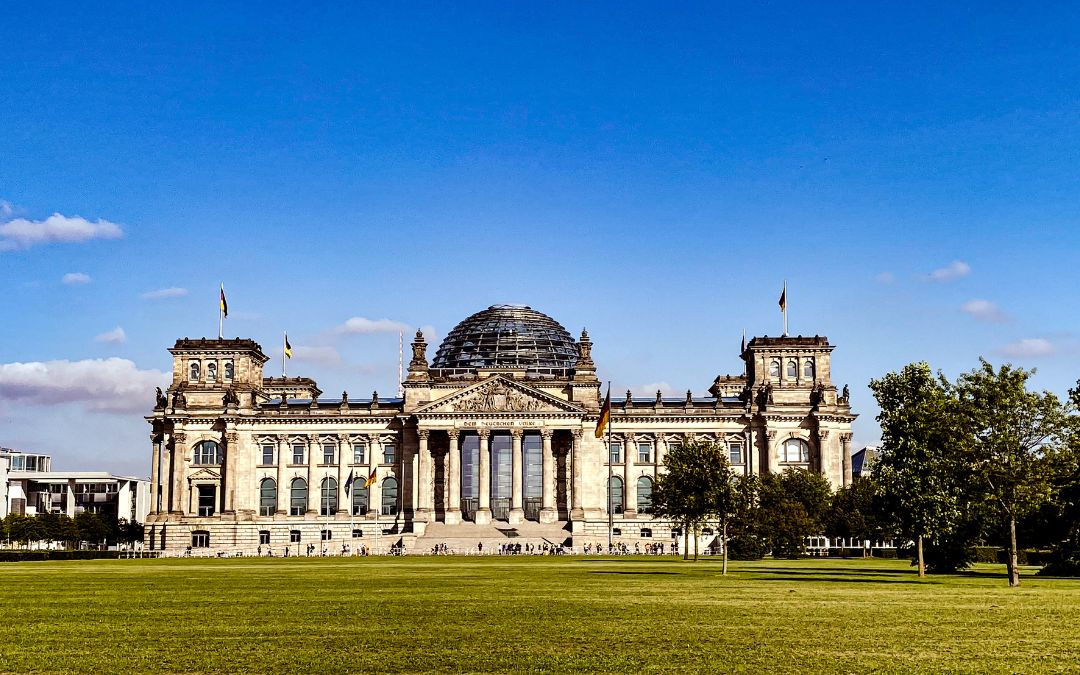
Berlin is with its colorful diversity, impressive sights and the incomparable cultural offer definitely one of the most fascinating cities in Germany. In addition, Berlin is a very green city with countless parks, lakes and forests. Hundreds of kilometers of water run through the city. On a boat tour on the Spree and Landwehrkanal you can get an overview of the most important sights such as the UNESCO World Heritage Museum Island, Chancellor's Office, Bellevue Castle and Berlin Cathedral - and that without any traffic jams!
Berlin is more a part of the world than a city.
However, Berlin also has its challenges. One of these is that the city has no real center due to decades of division into East and West. As a result, Berlin is perhaps less easily accessible to visitors than other major German cities such as Munich or Hamburg. Albeit, it is the traces and scars of history that contribute to Berlin's appeal: A visit to Berlin without East Side Gallery, Checkpoint Charlie and Potsdamer Platz seems impossible.
Even the darkest chapter of German history, the Nazi era, has left many traces in Berlin. On January 30, 1933, the Nazis celebrated Hitler with a torchlight procession through the Brandenburg Gate and transformed Berlin into the center of their terror within a few months. At the former site of the Reichsführung-SS, Sicherheitsdienst (SD) and Gestapo, there is today the memorial site Topography of Terror with changing exhibitions and a permanent exhibition about the seizure of power and the rule of the National Socialists between 1933 and 1945.
Last but not least, from Berlin you can enjoy trips to the Brandenburg countryside , for example to Potsdam with its castles and parks, for hiking in the Märkische Switzerland - e. g. on the Bollersdorf height -, or you visit a concert in the summer in the Chorin Monastery Ruins, the most important example of North German brick Gothic in the Mark Brandenburg.
Berlin is also worth a visit during Advent. In the capital there are a variety of Christmas markets for every taste. One of the most beautiful and popular of Berlin's Christmas markets is the Christmas Magic at Gendarmenmarkt.
- Join a guided tour of the Reichstag building to search for historical traces and be amazed by Norman Foster's spectacular glass dome .
- Explore the sights of Berlin-Mitte from Alexanderplatz via the Museum Island and the street Unter den Linden to the Brandenburg Gate.
- Enjoy Berlin's sights from a different perspective on a "bridge ride" while relaxing on board a ship that takes you across Berlin's waterways.
- In Potsdam, admire the palaces and gardens of Sanssouci, the "Prussian Versailles" (part of the UNESCO World Heritage "Palaces and Parks of Potsdam and Berlin„).
Staying overnight in Berlin - would you rather be in the middle of it all or classic western?
Berlin is big - not only in terms of area, but also in terms of diversity. This is particularly evident when it comes to accommodation. Most of the sights such as the Brandenburg Gate, Museum Island, Berlin Cathedral and the Reichstag are located in the district Centerthe historic center of the capital in the former eastern part. So if you want to discover a lot on foot and live close to the government district, the Spree and cultural highlights, this is the place to be.
The western part of the city around the Kurfürstendamm in the district Charlottenburg-WilmersdorfElegant Wilhelminian style buildings, the KaDeWe department store, the Memorial Church and a relaxed, old Berlin atmosphere characterize this district. Ideal for anyone who enjoys shopping, lingering in stylish cafés or ending the day in the Tiergarten or Charlottenburg Palace Park.
As these two districts are relatively far apart, it is worth considering before booking, Which part of Berlin suits your travel plans better - or whether you might even want to experience a combination of both.
That's why you get here for each accommodation category - from affordable to luxurious - One tip each for Mitte and Charlottenburg-Wilmersdorf.
Central district
Fair: Motel One Berlin-Spittelmarkt*
Modern, stylish and affordable - the Motel One Spittelmarkt is centrally located between Alexanderplatz and Checkpoint Charlie. Sights such as the Gendarmenmarkt and Museum Island are within easy walking distance. Perfect for anyone who values design and location without breaking the bank.
Comfortable: Garden Living - Hotel & Boarding House*
A little gem in the middle of Berlin: Garden Living is located just a few minutes from the main train station and delights with its charming boutique flair and tranquil garden ambience. If you want a stylish yet personal place to stay, this is the place for you.
Luxurious: Hotel Adlon Kempinski*
Located directly at the Brandenburg Gate, the legendary Hotel Adlon is an icon of Berlin's luxury hotel industry. Here you can stay at the highest level - with a view of the heart of the capital and a service that leaves nothing to be desired.
Charlottenburg-Wilmersdorf district
Fair: Mercure Hotel Berlin Wittenbergplatz*
Centrally located next to KaDeWe, the Mercure Hotel Berlin Wittenbergplatz offers excellent value for money. The design is modern, the connections are excellent - ideal for shopping fans and newcomers to Berlin who want to explore the classic West.
Comfortable: 25hours Hotel Bikini Berlin*
Cheeky, urban and creative - the 25hours Hotel directly at Bahnhof Zoo is anything but ordinary. With a view of the Tiergarten and an original interior, it is the perfect choice for anyone looking for an unconventional hotel experience.
Luxurious: Roomers Berlin Steinplatz, Autograph Collection*
This elegant design hotel in a beautiful Art Nouveau building combines stylish modernity with Art Deco flair. Its location in a quiet side street near Ku'damm and Savignyplatz makes Roomers an exclusive oasis in the heart of the West.
Bremen (Bremen): Brick Gothic and Weser Renaissance
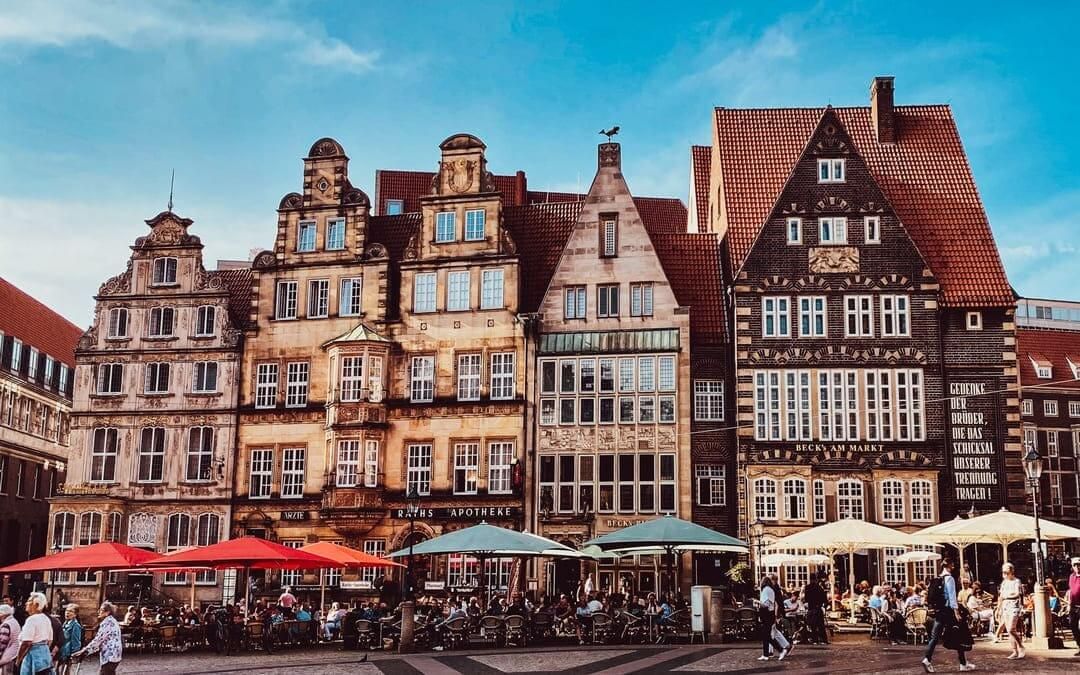
Bremen plays a special role in my biography. I lived and worked here for 8 years. My workplace was at the Domshof, a square framed by magnificent Weser Renaissance style bank houses So I was out and about in the city center every day. My daughter was also born in Bremen. So you can imagine that this city is very close to my heart.
But I don't think I'm off base when I say that Bremen's city center, with its many Gothic brick buildings, the unique expressionist Böttcherstraße,the winding alleys of the old town in the Schnoor quarter and the beer gardens on the Weser banks is simply beautiful.
Here I'm nothing, and would like to be something,
Because this city is real, and real is rare.
At Bremen's main attraction, the Market Square, you can spend hours if you want to take a closer look at the many sights. The grandiose City Hall and the huge Statue of Roland, both built at the beginning of the 15th century, are since 2004 UNESCO World Heritage sites - as outstanding symbols of the development of civic autonomy in the Holy Roman Empire. The most photographed sight in Bremen is probably the bronze statue of the Bremen Town Musicians by Gerhard Marcks on the west side of the town hall.
The Embankments (Wallanlagen), Citizen's Park (Bürgerpark) and Rhododendron Park are among the most beautiful urban green spaces in all of Germany. At the entrance to the trendy Ostertor/Steintor district (nowadays simply called "The Quarter" ), the Bremen Art Gallery is a museum of international standing with works from 700 years of art history (including Dürer, Monet, van Gogh, Picasso, Beckmann and Cage as well as the so-called "Worpswede painters").
Bremen also has great events to offer around the year, like the "Freimarkt" in October - the north German answer to Munich's Oktoberfest. The Bremen Christmas Market - one of the largest and most beautiful in Germany - takes place around the UNESCO World Heritage City Hall and Roland in Bremen It was expanded a few years ago to include the Schlachte Magic (Schlachtezauber) on the banks of the Weser river, which makes the market even more attractive.
Bremen is for me one of the most underrated major cities in Germany and is definitely one of my top 10.
- Marvel at brick Gothic and Weser Renaissance at Bremen's market square (with UNESCO World Heritage City Hall and Roland,).
- Stroll through the unique Böttcherstraße and along the Weser to the old town district Schnoor.
- Take a day trip to the North Sea coast of Lower Saxony and experience the UNESCO World Heritage Wadden Sea,a unique ecosystem on our planet.
- In the artists' village Worpswede (about 25 km from Bremen) in the middle of the Teufelsmoor, follow the traces of the painters Paula Modersohn-Becker and Heinrich Vogeler, the poet Rainer Maria Rilke and many other artists.
Staying overnight in Bremen - in the middle of it all or in the countryside?
Bremen's city center is compact, charming and full of sights: from Roland and the town hall to the Schnoor district and the Weser promenade "Schlachte". If you want to explore Bremen, a centrally located hotel is a clear advantage - everything is within walking distance and the cobblestones of the old town are not necessarily suitable for suitcases.
A little further from the center, but wonderfully green and elegant, is the villa-rich Schwachhausen around the Bürgerpark. The accommodation here is quieter and more dignified - ideal if you value wellness and relaxation as well as sightseeing. But beware: if you want to spend a lot of time in the old town, you should allow for the extra travel time.
Therefore you will find here for Bremen three hotel recommendations in different categoriestailored to different wishes and budgets.
Fair: Motel One Bremen*
Modern design meets unbeatable location: Motel One Bremen is just a few minutes' walk from the market square, Schnoor and Weserpromenade - perfect for anyone who wants to explore Bremen on foot. It's also just a few minutes by streetcar from the main train station.
Comfortable: H+ Hotel Bremen*
It couldn't be more central - and yet pleasantly quiet: the H+ Hotel is located in a side street on the edge of the Schnoor district, close to the market square and the Weser. The rooms are comfortable and modern, the breakfast is extensive. Ideal for a relaxed city trip with style, but without frills.
Luxurious: Parkhotel Bremen - a member of the Hommage Luxury Hotels Collection*
A genuine Bremen grand hotel with tradition and style: the 5-star Parkhotel is idyllically located on Holler See in Bürgerpark, in the middle of the upscale Schwachhausen district. Here you can enjoy peace, elegance and excellent service - with easy access to the city center by streetcar or cab. Perfect for anyone who wants to treat themselves to a break with a special flair.
Dresden (Saxony): Baroque splendor on the Elbe

The Saxon capital probably offers the most impressive city skyline in Germany. World famous buildings like Zwinger, Semper Opera House and Church of Our Lady characterize the baroque cityscape of the Elbe metropolis. The oldest building in the city, the former Catholic Court Church, is the largest church in Saxony and is considered the last masterpiece of Roman Baroque.
Several top-class museums are located in the former residential palace: The Historical and New Green Vault, the Coin Cabinet, the Kupferstich-Kabinett (Collection of Prints, Drawings and Photographs), the Armory and the famous Turkish Chamber. The Green Vault burglary on November 25, 2019made headlines worldwide - several objects of inestimable value were stolen from the treasury of Augustus the Strong.
The people of Dresden don't ask you if you like the city. They tell you.
This makes me think that cities can be classified
into two categories: the self-confident and the others.
All the magnificent buildings, which today shine again in their old splendor, are reconstructions. The Old Town of Dresden was destroyed to a large extent in the final phase of World War II by aerial bombing attacks . The ruins of the Frauenkirche were declared a "memorial against war" by the GDR government. It was not until after the fall of the Wall that reconstruction began in 1994 and was completed in 2005. The reconstruction of the Residence Palace with all its famous museums even lasted until 2013.
Dresden also offers a lot of variety for shopping fans : The Prager Straße is one of the most popular shopping areas in Europe and offers a variety of boutiques, restaurants and cafes. Dresden is known not only for its sights, but also for its festivals: Each year in May, the International Dixieland Festival takes place, where jazz musicians from all over the world present their skills. In June, the international music festival "Elbhangfest" and in July the Dresden Castle Night attracts visitors to the city. The final event in December is the Striezelmarkt, the oldest Christmas market in Germany, which has been held on the Old Market Square since 1494.
So there are many reasons why Dresden is considered one of the most beautiful cities in Germany - sightseeing, culture, shopping or festivals - here you will definitely find something to your taste! But what makes Dresden unique are the Baroque architecture and the art treasures of Augustus the Strong, which gave Dresden the nickname "Elbflorenz" .
- Visit the world famous Semper Opera, best in combination with a guided tour through the historical old town.
- Take a boat trip on the river Elbe! Especially in Dresden this is worthwhile, because from the ship you have a wonderful view of the baroque skyline on the Elbe banks.
- Discover the cultural landscape of the Dresden Elbe Valley, which was a UNESCO World Heritage Site until 2009. The title was lost with the construction of the Waldschlösschen Bridge, but the area has not become less worth seeing. This is another reason why I highly recommend doing a boat trip when you're in Dresden.
- Undertake a Excursion to Saxon Switzerland. The Elbe Sandstone Mountains are a natural wonder just outside Dresden.
Spend the night in Dresden - right in the middle of baroque splendor
Dresden is one of the most beautiful cities in Germany - mainly because of its impressive old town. Here you will find world-famous sights such as the Church of Our Lady (Frauenkirche),, the Kennel, the Semper Opera or the Residential Palace - and all in a confined space.
A hotel in the old town is therefore ideal if you want to explore the city on foot and appreciate short distances. Restaurants, museums and the banks of the Elbe are just a stroll away, and in the evening you can enjoy the view of the illuminated sandstone façades with a glass of wine.
The hotels I recommend here are all in prime locations in the heart of Dresden's old town - for an all-round successful stay in Elbflorenz.
Fair: Motel One Dresden am Zwinger*
Stylish accommodation at a low price - directly opposite the Zwinger. The Motel One boasts modern furnishings, comfortable beds and an elegant lobby area with a view of the baroque facades of the old town. Ideal for anyone looking for a top location without breaking the bank.
Comfortable: INNSiDE by Meliá Dresden*
A real insider tip for design lovers: INNSiDE is located in the historic old town, just a few steps away from the Frauenkirche. Particularly beautiful: the view from the stylish SkyBar over the rooftops of Dresden. There is also a small but excellent wellness area with sauna and steam bath - all inclusive.
Luxurious: Hotel Taschenbergpalais Kempinski Dresden*
Baroque meets modern luxury: this traditional 5-star hotel opposite the Zwinger was once an aristocratic palace and is now one of the best addresses in the city. Elegantly furnished rooms, excellent service and a spacious spa area make the Taschenbergpalais the first choice for a stylish stay in the heart of the historic city center.
Erfurt (Thuringia): Luther, Meister Eckhart and Jewish medieval world heritage

Thuringia's capital Erfurt is rich in history and culture. The Cathedral Hillwith its magnificent ensemble of St. Mary's Cathedral and Severi Churche, is considered the landmark - it is also worth visiting the interior of both churches.
The city's second landmark, the Krämerbrückeis the longest continuously built and inhabited bridge in Europe. I can recommend the delicious chocolates from Goldhelm Schokoladen Manufaktur, which runs a bridge store, as a souvenir. Two houses further on, the ice cream parlor sells Goldhelm ice cream for immediate enjoyment.
Be sure to also explore the Petersberg Citadelthe only almost completely preserved baroque city fortress in Europe. This historic fortress offers an incomparable view and immerses you in the military history of Baroque Europe.
The spirit of the Reformation fills the Protestant Augustinian Monasterywhere Martin Luther lived between 1505 and 1511 and read his first mass in 1507. Luther studied and worked in the Luther cell and slept in the dormitory with the other monks.
The theologian and mystic Master Eckhart (1260 - 1327) was a Thuringian. The Preacher Church is today one of the few authentically preserved buildings that bear witness to his life and work.
Be aware of yourself. And where you find yourself, leave yourself there.
Fish caught in the Gera, but also in the North and Baltic Seas, was once traded at the fish market. Since the 13th century, a town hall has stood on this square, which was also a court of law - the original was replaced in 1875 by today's neo-Gothic town hall. Other magnificent Renaissance façades, such as those of the houses Zum Roten Ochsen and Zum Breiten Herd, bear witness to the wealth of their builders.
Since September 2023, the Jewish medieval heritage of Frankfurt has officially been part of the UNESCO World Heritage Site. The three surviving World Heritage monuments - the Old Synagogue, the Mikveh and the Stone House - are rare and exceptionally well-preserved examples of Jewish buildings in Central Europe and offer an insight into the flourishing Jewish life, as well as the history and coexistence of the Jewish communities with the predominantly Christian population in medieval Europe.
The historical sights, rich history and relaxed atmosphere make Erfurt one of the most worthwhile cities to visit in Germany.
Tip: If you are in Erfurt, you should definitely visit the nearby Classical city of Weimar (less than 15 minutes away by train). A trip to Wartburg Castle (UNESCO World Heritage Site) near Eisenach is also well worthwhile.
- UNESCO World Heritage Site - Jewish-Medieval Heritage: Take part in a guided tour of the Old Synagogue and the Mikveh, discover the Erfurt Treasure and learn lots of interesting facts about Erfurt's Jewish community, which was important in the Middle Ages.
- The KrämerbrückeStroll along Europe's longest continuously built-up and inhabited bridge street, which invites you to linger with its small stores and cafés.
- St. Mary's CathedralMarvel at the imposing ensemble of the cathedral and the neighboring Severi Church, which are majestically enthroned above the city on the Domberg.
- Petersberg CitadelDiscover the only almost completely preserved baroque city fortress in Europe with its breathtaking panoramic view over Erfurt.
Stay overnight in Erfurt - right in the historic heart of the Thuringian state capital
Erfurt boasts one of the most beautiful old towns in Germany: the cathedral square, the Krämerbrücke bridge, the Augustinian monastery and many other sights are close together - perfect for exploring the city on foot.
Whether you're traveling on a budget or want to treat yourself to a little more comfort: In Erfurt's old town, you'll find the right hotel for every budget - and plenty of atmosphere right on your doorstep.
Fair: B&B Hotel Erfurt-Hauptbahnhof*
Just a few minutes' walk from the main train station and the old town, the B&B Hotel offers modern, functional rooms at a fair price. Perfect for anyone who wants to stay close to the city center and still keep an eye on their budget.
Comfortable: Mercure Hotel Erfurt Old Town*
Centrally located, but quiet in a side street: the Mercure Hotel combines old town flair with solid 4-star comfort. The sights around the cathedral square and the Krämerbrücke bridge are within easy walking distance - ideal for a relaxing stay in Erfurt.
Upscale: Hotel Alma Am Anger*
A stylish insider tip in the old town: the Hotel Alma Am Anger impresses with its elegant design, a rooftop terrace with a view over the city and high-quality rooms. If you want to combine modern comfort with a special ambience, this is the place for you.
Hamburg (Hamburg): Maritime flair and the largest warehouse ensemble in the world

Germany's second largest city (after Berlin) inspires with its maritime flair, a vibrant cultural scene an exciting nightlife. For several years, the Hanseatic city on the Elbe has been thrilling with modern architecture, which forms a fascinating connection with the historical buildings. The Elbphilharmonie, opened in 2017, is Hamburg's newest landmark. It has given the city a new stage for top-class concerts, which alone attracts hundreds of thousands of visitors per year. The "Elphi" is the HafenCity's tourist magnet -currently the largest inner-city development project in Europe. On an area formerly belonging to the free port, a total of over 6,000 apartments and up to 45,000 jobs will be built here by 2025 (at the earliest).
From an administrative point of view, HafenCity also includes the historic Speicherstadt, another highlight of Hamburg and together with the Kontorhausviertel and Chilehaus UNESCO World Heritage Site since 2015. The red brick buildings built into the water between Baumwall and Oberhafen form the largest warehouse ensemble in the world. In addition to offices, apartments and stores, the former warehouses from the 19th century now house some of Hamburg's most popular attractions, such as the Miniature Wonderland and Hamburg Dungeon.
Legendary is the Hamburg Kiez, the Reeperbahn including its side streets in the St. Pauli district. At the site of the famous Star Club, however, only a memorial plaque commemorates the performances of the Beatles in the early 1960s. On the Kiez, there are not only the establishments typical of red-light districts, but also the Wax Museum Panopticon, as well as musical and theater stages, such as the Operetta House (Operettenhaus), the St. Pauli Theater and Schmidt's Tivoli.
Hamburg is the best republic.
Its customs are English and its food is heavenly.
From the St. Pauli Landing Bridges it is not far to another Hamburg landmark, the Michel. The 132 m high tower of the beautiful baroque church St. Michaelis can be seen from almost every point in Hamburg's city center. From the viewing platform of the Michel you have a magnificent view of the Elbe and over the city.
You can experience one of the most beautiful sides of Hamburg in the heart of the city at the Binnenalster. Like the much larger Outer Alster - an adventure and nature paradise in the middle of the city - this artificial lake was created by damming the river. Hamburg's most famous shopping and promenade is the Jungfernstieg, which was already built in 1665 on the southern bank of the Binnenalster. From the cafés and restaurants as well as the open staircases on the shore you can enjoy a magnificent view of the Binnenalster with the Alster Fountain and the impressive silhouette of Hamburg's most prestigious hotels - the Hotel Atlantic and Hotel Four Seasons.
As befits a major city, Hamburg offers a variety of festivals and events, such as the Hamburg Harbour Birthday, founded the Elbjazz Festival, the Christopher Street Day, and the Reeperbahn Festival for musical newcomers. Three times a year the Hamburg DOM one of the largest public festivals in Germany. In the Advent season Hamburg attracts with traditional as well as unconventional Christmas markets - the most visited is the Historic Christmas Market at Rathausmarkt - Visitors from home and abroad to the city.
I love Hamburg's Hanseatic flair, which I particularly enjoy at the Binnenalster and in the Speicherstadt. That alone makes the city always worth a visit for me. The cultural offerings and the many attractions are unparalleled! Thus, Hamburg is definitely one of the most beautiful cities in Germany!
- Explore Kontorhaus Quarter, Chilehaus, Speicherstadt and HafenCity on foot. Take a break at one of the beautiful cafés in the Speicherstadt along the way.
- Discover the Port of Hamburg and the Speicherstadt on a boat trip.
- Take a walking tour of Hamburg's city center including City Hall, St. Petri, Gänsemarkt, Mönckebergstraße and Binnenalster.
- Take a trip to the Old Land (Altes Land) just outside Hamburg to get to know Germany's largest contiguous fruit-growing region. Visit one of the picturesque former Hanseatic cities Stade: or Buxtehude with its many beautiful half-timbered buildings.
Staying overnight in Hamburg - Hafencity, Alster or the classic West?
Hamburg offers plenty of variety: whether you prefer to live directly in the pulsating Harbor City with the Speicherstadt warehouse district and the Elbphilharmonie concert hall on the doorstep - or in a charming neighborhood like St. George on the Alster, very close to the city center - the choice is huge. Although Hafencity and the Alster are a little apart, you can quickly get from one district to the other thanks to good public transport.
That's why you'll find three recommendations here - from comfortable middle class hotel until elegant luxury classics - each in an ideal location for your visit to Hamburg.
Fair: B&B Hotel Erfurt-Hauptbahnhof*
Just a few minutes' walk from the main train station and the old town, the B&B Hotel offers modern, functional rooms at a fair price. Perfect for anyone who wants to stay close to the city center and still keep an eye on their budget.
Comfortable: Mercure Hotel Erfurt Old Town*
Centrally located, but quiet in a side street: the Mercure Hotel combines old town flair with solid 4-star comfort. The sights around the cathedral square and the Krämerbrücke bridge are within easy walking distance - ideal for a relaxing stay in Erfurt.
Upscale: Hotel Alma Am Anger*
A stylish insider tip in the old town: the Hotel Alma Am Anger impresses with its elegant design, a rooftop terrace with a view over the city and high-quality rooms. If you want to combine modern comfort with a special ambience, this is the place for you.
Heidelberg (Baden-Württemberg): The most sublime ruins and the most famous walking trail in Germany

This unique view of the city and the castle is only available from the Philosopher's Path
The castle ruins high above the city is one of the most romantic places in Germany and testimony to an eventful past. You have to earn the famous postcard views of Heidelberg Castle and old town by hiking the Philosophenweg on the Heiligenberg .
Germany's oldest and most famous university town is especially popular for its romantic atmosphere, its historic old town and its idyllic location on the Neckar river. The city is surrounded by forests, which invite for long walks. The most beautiful part of Heidelberg's old town is around the upper, eastern part of Main Street (Hauptstraße), where the Old Bridge, the university and the view of the castle form the cityscape.
A ruin must be rightly situated, to be effective.
This one could not have been better placed.
All this already attracted the romantics of the late 18th and early 19th century to Heidelberg, first and foremost Johann Wolfgang von Goethe. The British painter William Turner contributed significantly to the Heidelberg boom with his famous paintings of the Heidelberg castle ruins.
Throughout the year, Heidelberg has beautiful festivals that attract a mixed national and international audience to the beautiful university city, such as the Heidelberg Spring (March/April) or the Castle Festival (June/July). In my opinion the Heidelberg Christmas Market is one of the most beautiful in Germany and a good reason to visit the city in December
With its student atmosphere, the great cultural offer, the historical buildings and magnificent viewpoints Heidelberg is pretty high on the list of the most beautiful German cities for me.
- Take a ride on the cable car from Corn Market to probably the most famous castle ruin in the world, Heidelberg Castle, and enjoy the second best view of Heidelberg from the Great Terrace.
- Walk from Bismarckplatz across Theodor-Heuss-bridge along the Philosopher's Path and across the "Old Bridge" (Karl-Theodor Bridge) back to the city center. Enjoy the best view of Heidelberg from Philosopher's Garden and Meriankanzel (!) .
- Stroll along the Main Street from Bismarckplatz to Market Square with side trips on both sides. From Corn Market you have a beautiful view of the castle. The oldest university library Germany is worth a visit!
- Take a trip to the Schwetzingen Castle, the former summer residence of the Palatine electors, about 12 km west of Heidelberg,
Staying overnight in Heidelberg - close to the old town, flair and the Philosophers' Walk
Heidelberg is one of the most romantic cities in Germany - and this is also reflected in its charming accommodation. Most of the sights such as the Castle, the Old bridge and Hauptstrasse (Main Street) are located in or near the old townaround Bismarckplatz. If you live there, it's not far to cafés, museums and the mountain railroad.
The district is somewhat quieter, but no less attractive Neuenheim on the other side of the Neckar - mainly because of its proximity to Philosophenweg and its green, dignified ambience.
Here you will find three personally selected hotels - from affordable to luxurious - for a stylish stay in the most beautiful city on the Neckar.
Fair: Heidelberg Excellence Hotel*
This well-kept mid-range hotel is just a few minutes' walk from Bismarckplatz and the main street - ideal for exploring the old town on foot. The nearest streetcar stop is at Adenauerplatz, directly accessible from the main train station. Good value for money for those who want to stay comfortably and close to the city center.
Comfortable: BS Boutique Hotel Heidelberg*
A lovingly designed, barrier-free hotel in a historic building in the Neuenheim district. The tastefully furnished rooms are spread across the old and new buildings, many of which have a view of the greenery. The Alte Brücke and the entrance to Philosophenweg are around a 10-minute walk away - perfect for those who like it quiet and stylish.
Luxurious: Hotel Europäischer Hof Heidelberg*
Tradition meets modern comfort: this privately run 5-star hotel is located on the edge of the old town, close to Bismarckplatz. In addition to individually furnished rooms in various categories, you can expect a stylish spa area, elegant service and, in summer, a rooftop pool with a view over the city - a true classic among luxury hotels in Germany.
Leipzig (Saxony): City of Bach and cradle of the peaceful revolution
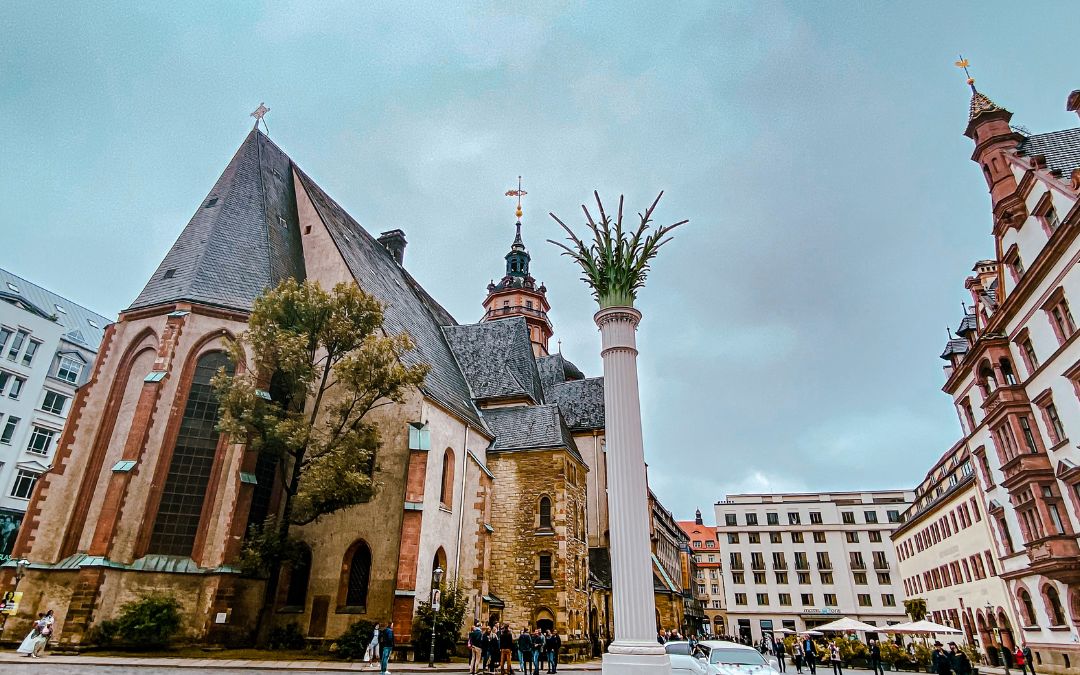
Coffee and Leipzig belong together. Germany's first coffeehouse musicians entertained their guests in Leipzig: In the 18th century, Georg Philipp Telemann played music with the Collegium musicum in the coffeehouses around the market square. Bach's coffee cantata is considered the pinnacle of Saxon coffeehouse music. The baroque "Coffee Tree" was opened in 1694 and is one of the oldest coffee houses in Europe.
From the "Coffe Baum" it is only a few steps to St. Thomas Church,in the courtyard of which you will find Johann Sebastian Bach's bronze statue, who came to Leipzig in 1723 as Thomaskantor and music director, a position he held until his death in 1750. During this time he also directed the St. Thomas Boys Choir, which still maintains the musical legacy of its most famous former cantor with performances all over the world.
Oh, how I always envy Leipzig for its music.
After a few steps from St. Thomas' Church, you reach the Market Square with the Old Town Hall, one of the most beautiful Renaissance buildings in Germany. At its rear is the Naschmarkt. On its northern side the is the baroque Old Stock Exchange. In front of it is a monument to the young Johann Wolfgang von Goethe, who studied in Leipzig and got inspiration for at least one scene of Auerbach's Keller in the nearby Auerbach's Keller .
An important role in the history of the German reunification played the St. Nicholas Church. In 1999, a replica of one of the palm-crowned columns inside the church was set up in the churchyard as a peace column in memory of the Monday demonstrations and peaceful revolution .
The Monument to the Battle of the Nations was built to commemorate the fallen of one of the bloodiest battles in history. The Battle of the Nations or Battle of Leipzig took place in the October 1813 between Napoleon and his allies and the coalition armies of Austria, Prussia, Sweden and Russia. You have to climb 364 steep steps in a rather narrow corridor to get to the top of the Monument to the Battle of Nations. The 360° view of Leipzig and its surroundings will make you forget the effort - I promise!
With major events such as the Leipzig Book Fair (March), the Bach Festival Leipzig (June) and the Leipzig Christmas Market - one of the most traditional and largest in Germany - Leipzig offers great events for every taste all year round. Due to its fascinating history, the many beautiful cafes and youthful atmosphere Leipzig is clearly one of my favorite cities in Germany!
- Climb the Monument to the Battle of the Nations and enjoy a breathtaking panoramic view of Leipzig and its surroundings.
- Stroll through the Mädler Passage,Leipzig's most beautiful shopping arcade, and go on a journey back to Goethe's student years in Auerbach's Keller .
- In the Museum in the Round Corner, the former headquarters of the GDR's State Security Service, find out about the Stasi's methods and machinations.
- Take a boat ride in the Neuseenland just outside Leipzig, where the remaining holes of the open-cast lignite mine have been transformed into a unique recreational landscape with 19 lakes.
Accommodation in Leipzig - hotels for every budget and every taste
Leipzig's city center is compact and diverse: the old town, opera, Gewandhaus and numerous museums are located around Augustusplatz and the main train station. If you like to stay centrally and want to explore the city on foot, you're in good hands here. In this selection you will find hotels that impress with their location, style and value for money - from budget-friendly design hotels to elegant luxury hotels.
Fair: Motel One Leipzig-Augustusplatz*
Top location close to Augustusplatz, just an eight-minute walk from the main train station. Modern design, comfortable beds and a stylish lobby bar make Motel One the ideal choice for anyone who wants to stay in a central location at a reasonable price. Discounted parking is available in the parking garage under Augustusplatz.
Comfortable: Seaside Park Hotel Leipzig*
An Art Nouveau hotel with lots of charm, directly opposite the main train station - perfect for anyone arriving by train. The interior is stylishly decorated in Art Deco style and the rooms are soundproofed. The breakfast is very good and plentiful, but the restaurant is located in a windowless room.
Luxurious: Steigenberger Icon Grandhotel Handelshof*
This traditional 5-star hotel is located directly on the Naschmarkt, just a few steps away from the Old Town Hall. Elegantly furnished rooms, a spacious spa area with sauna and steam bath and first-class service make the Grandhotel the best address for anyone who wants to treat themselves to something special in Leipzig.
Lübeck (Schleswig-Holstein): Brick Gothic, Nobel Prize winner and Baltic Sea breeze
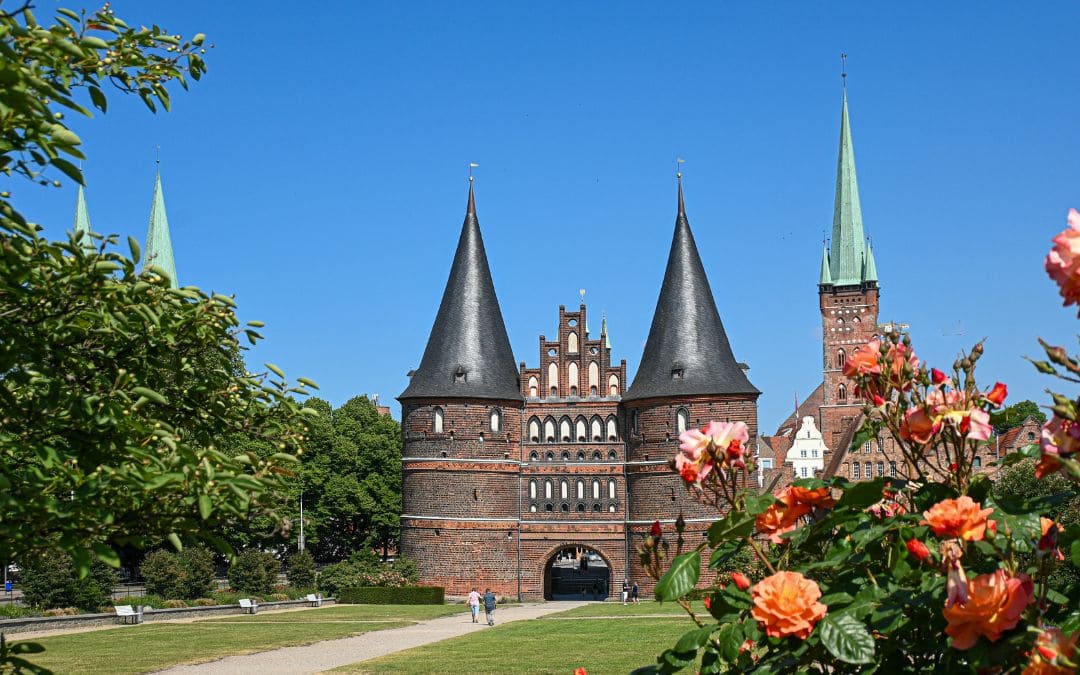
Lübeck took my heart by storm on my very first visit. Sea, literature, brick Gothic and marzipan - I find this quartet simply irresistible. I went there twice during a week's vacation on the Baltic Sea and will definitely be back.
In 1987, Lübeck's Old Town was the first city quarter to be added to the UNESCO World Heritage List. From 1230 to 1535, Lübeck's historic old town played a key role in the Hanseatic League, the most important trading alliance of the Middle Ages. Although Lübeck did not survive the Second World War unscathed, the historic old town structure was largely preserved. Outstanding sights include the famous Holsten Gate, five Gothic brick churches, the beautiful town hall, the castle monastery, stately patrician houses and the salt warehouses on the banks of the River Trave. Founded in 1143 as the first "occidental city on the Baltic coast", Lübeck has a rich past as one of the early centers of world trade.
The city of Lübeck has set up museums for its three Nobel Prize winners. The former home of Thomas Mann's grandparents is one of Lübeck's most visited sights as the setting for his novel of the century "The Buddenbrooks". The former Chancellor of the Federal Republic of Germany and Nobel Peace Prize winner Willy Brandt grew up in Lübeck as Herbert Frahm - he only called himself Willy Brandt after the beginning of the Nazi dictatorship, when he went into hiding in Oslo. The third member of the group is Günter Grass, the 1999 Nobel Prize winner for literature, whose office was located in what is now the Günter Grass House, although he was born in Gdansk.
The sea is not a landscape, it is the experience of eternity.
Just outside the city gates, Lübeck's Baltic Sea spa resort of Travemünde attracts visitors with its maritime flair. In summer, you can visit Travemünde's landmark, the four-masted barque "Passat", which lies picturesquely on the Trave estuary.
The best view of Lübeck is from the tower of St. Peter's Church, which was once the church of the fishermen. First you have to climb a few steps, but then an elevator takes you comfortably to the viewing platform.
- Get an overview of the old town with its five churches, the magnificent town hall and the ships on the Trave and (in good weather) all the way to the Baltic Sea from the Tower of St. Peter's Church. You won't forget this view!
- Experience Lübeck's landmark, the Holsten Gatefrom all perspectives and at all times of day - especially in the evening light, when the red brick glows with particular intensity.
- Dive into the Buddenbrook House into the world of the Mann family. Thomas Mann portrayed his own family, an old-established Lübeck merchant family, as the "Buddenbrooks".
- Enjoy a relaxing cruise on the Trave and experience the city from a new perspective.
- Stroll through the charming Gängeviertel and discover the winding alleyways and historic houses that give Lübeck its medieval charm.
- Discover the sweet side of Lübeck and indulge yourself in the traditional Café Niederegger with a piece of delicious marzipan nut cake.
Staying overnight in Lübeck - my tips for fans of the old town and comfort seekers
The Hanseatic city of Lübeck impresses with its well-preserved old town, the Holsten Gate, winding alleyways and its proximity to the River Trave. If you want to experience the UNESCO-protected city center in depth, you should treat yourself to a hotel in the center - because many of the most beautiful sights are within walking distance of each other.
Whether you prefer to stay in style right in the old town or want something quieter but still close to the city center - here are three hotel tips for different budgets and requirements.
Fair: Motel One Lübeck*
Modern design, beautiful lounge and functional rooms in a prime old town location - the Motel One impresses as usual with well thought-out comfort at a fair price. The hotel is located directly on Rathausmarkt - ideal for strolling through the city, visiting museums and enjoying culinary delights in Lübeck's old town.
Comfortable: Holiday Inn Lübeck by IHG*
The spacious Holiday Inn with modern, well-equipped rooms is located just outside the historic old town, but only a few minutes' walk from the Burgtor. An indoor pool, a fitness area and a rich breakfast buffet ensure relaxing days of well-being in the Hanseatic city.
Luxurious: Atlantic Hotel Lübeck*
In the heart of the old town, close to St. Mary's Church and Klingenberg, the Atlantic Hotel Lübeck offers stylish rooms, fine dining and a beautiful roof terrace with a view over the city. If you are looking for an elegant, centrally located hotel with excellent service, this is the place for you.
Munich (Bavaria): Top-class museums and the Bavarian way of life
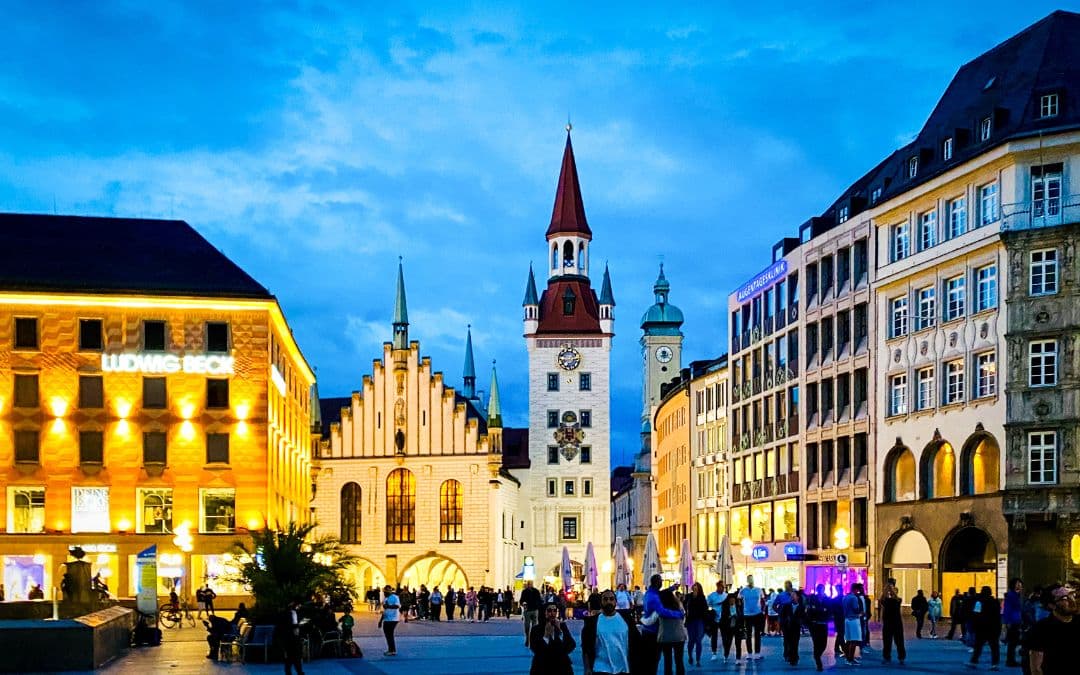
Munich enjoys a global reputation in many respects: as a Center of the Arts, as most livable city in Germany, as German beer and veal sausage capital, home to global players from a wide range of industries, most expensive city in Germany ... The superlatives for the Bavarian capital are almost endless. Add to that the charming location with lakes and mountains on the doorstep.
The heart of the city beats on Marienplatz and around. THE tourist attraction on Marienplatz is the bell and figure show in the Town Hall tower, which makes its rounds daily at 11 a.m. and 12 p.m. (from March to October also at 5 p.m.). A few steps away from the town hall stands Munich's landmark, the Church of Our Lady, a late Gothic brick hall church. Munich's oldest parish church, St. Peter's Church (built in the 11th century), is on the north side of Viktualienmarkt,where well-heeled Munich residents can stock up on delicacies on weekdays. Here you can take a break in the popular Beer garden .
One of the most famous historical buildings in Munich is the is one of the most beautiful and traditional Christmas markets in Bavaria and delights its visitors with a festive atmosphere against the impressive backdrop of the Falkenhaus and the Gothic St. Mary's Chapel (Marienkapelle). More than 100 lovingly decorated stalls shine in the city's historic market square during the Advent season, offering a wide range of handcrafted products, Christmas decorations and regional delicacies. The Würzburg Christmas market is particularly famous for its handmade nativity figures and traditional wooden toys, which are made in the region., , which is located on the equally famous Odeonsplatz. This largest inner-city palace complex in Germany was the Residence of the Bavarian dukes, electors and kings from 1508 to 1918. The magnificent rooms and richly endowed art collections speak for the artistic sense and political ambitions of the ruling house of Wittelsbach. After the end of the monarchy in Bavaria, the residence was converted into a museum in 1918. The Cuvilliés Theater from the 18th century in the Residence is considered the most beautiful rococo log theater in Europe.
If you like shopping, you will love to stroll through Neuhauser Strasse and Kaufinger Strasse, as well as the exclusive Maximilianstrasse, Munich's most expensive shopping street.
Between art and beer, Munich is like a village nestled between hills.
For art and technology fans, Munich's world-class museums has a lot to offer. In the Alte Pinakothek 800 works of old masters from Dürer to Raphael to Velázquez are on display, collected by the Wittelsbach dukes and electors. In the Neue Pinakothek directly opposite, European art from classicism to art nouveau is presented. Here you will find, for example, works by Caspar David Friedrich, Gustav Klimt, Claude Monet, van Gogh and Gaugin. The Pinakothek of Modern Art,which unites four museums under one roof, is Germany's largest and possibly also most beautiful museum for modern art, with works of the 20th and 21st century by Beckmann, Kirchner, Chagall, Dalí, Picasso and many others. The German Museum is Europe's largest technical and natural science museum. Car fans will love the German Museum Traffic Center and BMW World .
In the west of the city you can visit Nymphenburg Palace, summer residence and favorite palace of the Wittelsbach dynasty. It is one of the largest castles in Germany and Europe. Ludwig II, later builder of Neuschwanstein Castle and other magnificent Bavarian castles, was born here.
In the midst of all this culture, don't forget to take plenty of time to stroll through the picturesque downtown area and the English Garden to take, one of the largest parks in the world with many attractions. In the city's numerous beer gardens you can enjoy the relaxed atmosphere, typical Bavarian dishes and of course the famous Bavarian beer in the warm season. In September (!) the Oktoberfest every year millions of tourists from all over the world to the largest folk festival in the world. With a wide range of Christmas markets - from the classic, the Munich Christkindlmarkt (Christmas market) aroundMarienplatz, to the alternative TollWood Winter Festival - December is also quite an appealing month to travel to Munich, especially since the snow-covered mountains are just outside the city gates.
The contrast between tradition and modernity, art and commerceyou can observe everywhere in Munich makes this city tremendously attractive. Munich is regularly voted the most livable city in Germany - for those who can afford it.
- Explore the city center between Karlsplatz (Stachus) and English Garden on foot.
- Enjoy the dreamlike view of the city from one of the viewing platforms of City Hall, Frauenkirche or St. Peter's Church.
- If you are in Munich for the first time, a visit to the Hofbräuhaus is a must!
- Take a day trip to the beautiful Munich surroundings, for example to Lake Ammersee, Lake Starnberg or Lake Chiemsee.
Staying overnight in Munich - charming, comfortable and (not quite cheap)
Munich is not only one of the most popular, but also the most most expensive city in Germany - and this is particularly evident in hotel prices. If you want to stay centrally, you have to expect significantly higher costs than in many other cities. Nevertheless, a well-located hotel is worthwhile, as many sights such as Marienplatz, Viktualienmarkt or the Residenz are within walking distance - and the atmosphere between the Isar, beer gardens and old town alleyways is incomparable.
Here you will find three personal recommendations - from solid design hotels to stylish luxury retreats right in the city center.
Fair: Motel One Munich-Haidhausen*
Reliable Motel One comfort in a charming French Quarter of Haidhausen. Ostbahnhof station is just a few minutes' walk away, and Marienplatz is around 15 minutes away by S-Bahn. There are many nice cafés, bars and restaurants in the area - ideal for anyone looking for pleasant but affordable accommodation close to the city.
Comfortable: Platzl Hotel Munich*
Traditional 4-star hotel in a perfect Old Town location - just a few steps from Marienplatz, Viktualienmarkt and Hofbräuhaus. The rooms are elegantly and comfortably furnished, the breakfast is excellent. Especially nice: the hotel's own bar "Josefa" and the excellent Bavarian restaurant "Wirtshaus Ayinger".
Luxurious: Mandarin Oriental, Munich*
One of the most exclusive hotels in the city - stylish, discreet and centrally located near Maximilianstraße and Hofbräuhaus. The Mandarin Oriental offers luxurious rooms with modern comforts, an elegant spa area and a spectacular roof terrace with a view over the rooftops of Munich. A place for the highest standards - both in terms of facilities and service.
Nuremberg (Bavaria): Light and shadow of German history
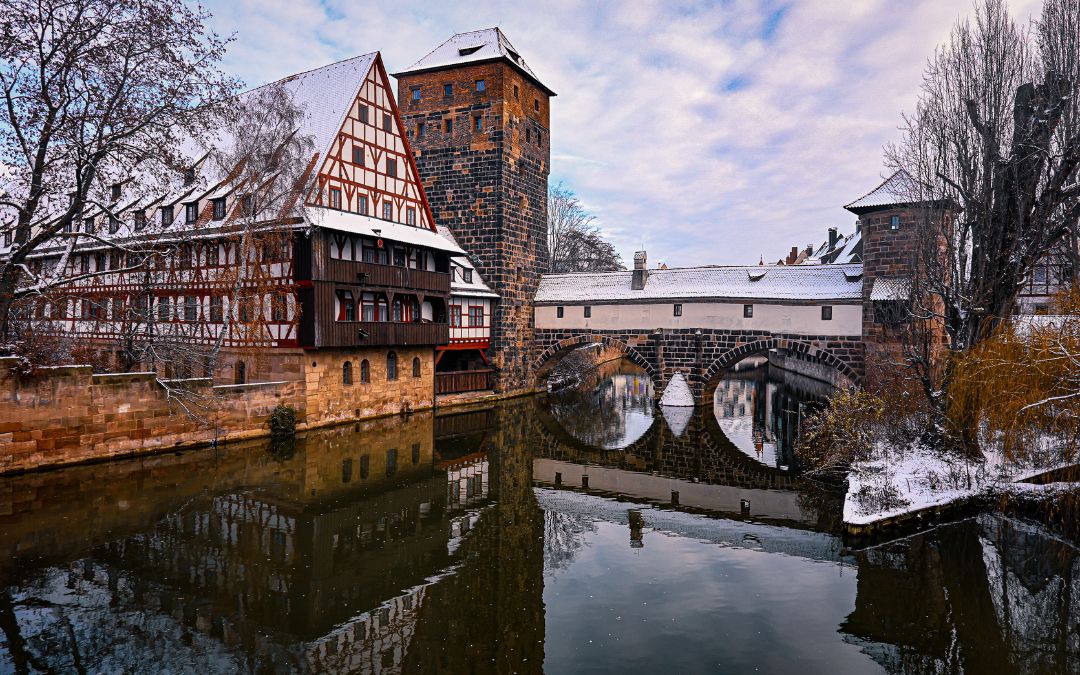
Nuremberg is one of the most historic German cities. It is known as Imperial city, Dürer city, city of toys and the Christkindlesmarkt, gingerbread and Bratwursts, but also the NS Party Rallies and the Nuremberg War Crimes Trial.
The Imperial Castle is probably Nuremberg's best-known landmark. In the "Golden Bull" of 1356, Emperor Charles IV had stipulated that every newly elected emperor must hold his first imperial diet in Nuremberg. Alongside Frankfurt as the city of the election of kings and Aachen as the city of the coronation of kings, Nuremberg was thus a power center of the empire.
In the final phase of the World War II, Nuremberg's Old Town was almost completely destroyed. In 1947, it was decided to reconstruct the city in a simplified way.Some historic buildings were preserved despite considerable damage (including the Imperial Castle, the Town Hall Wolffscher Bau, the Church of Our Lady, St. Sebald and St. Lawrence). Most of the reconstruction work had already been completed by 1955.
A wonderful place to experience the charms of the old Nuremberg is Tiergärtnertorplatz, , which is preserved as a closed medieval square. In fine weather, many visitors simply sit down on the cobblestones with their drinks and enjoy the hustle and bustle. Albrecht Dürer's House,where the master lived from 1509 until his death in 1528, is located at the edge of the square. The exhibition in the house provides insights into the life and work of the most important German artist of the Renaissance.
Every working day, there is a food market at Nuremberg's Hauptmarkt a food market takes place. During the Christmas season here will be the stalls of the world famous Nuremberg Christkindlesmarkt (Christmas market) built up. Until the Second World War, the main market was an architectural gem of Nuremberg. After the war, the square was rebuilt only in a very simplified form. The only historical buildings are the Church of Our Lady (Frauenkirche), and Schöner Brunnen (Beautiful Fountain). The main attraction of the church is the "Männleinlaufen" below the clock face, where every day at 12 o'clock the seven electors circle their emperor Charles IV. Like Nuremberg's two other large churches, St. Sebaldus and St. Lawrence, the Frauenkirche houses important works by artists such as Veit Stoß, Peter Vischer and Adam Kraft.
Nuremberg shines among the cities like the sun among the stars.
The Germanic National Museum is the most important cultural history museum in Germany. The Nuremberg artists Albrecht Dürer, Veit Stoß and Adam Kraft are represented with numerous works. One of the most significant exhibits is the oldest globe in the world from Martin Behaim which shows the world still without America. The Karthäusergasse in front of the Germanic Museum was redesigned in 1993 by the Israeli artist Dani Karavan as the "Way of Human Rights" .
The New Museum - State Museum of Art and Design with its 100-meter-long curved glass facade is a masterpiece by Berlin architect Volker Staab. The highlight of the equally spectacular interior design is a staircase spiral that evokes associations with New York's Guggenheim Museum. The Neues Museum shows on more than 3,000 m2 Art and design from the 1950s to the present.
An impressive place of remembrance is the Memorium Nuremberg Trials. Since November 21, 2022, in the Nuremberg Palace of Justice, you can experience the media installation "Court Room 600: Time Travel" At the historic site of the Nuremberg Trials, this virtual journey through time takes you back to the period of the trial between November 20, 1945 and October 1, 1946. Outside the courtroom, a permanent exhibition in several exhibition rooms provides information about the prehistory, participants and course of the Nuremberg War Crimes Trial.
Hardly anywhere in Germany are the legacies of the Nazi dictatorship as visible as in Nuremberg. The former Nazi Party Rally Grounds, where the mass events of the NSDAP were held, is today Nuremberg's largest recreational area with lakes, parks, soccer stadium, ice hockey arena and car racing track. The Documentation Center is currently being rebuilt, but there is an interim exhibition on the history of the area. In addition, the association Geschichte Für Alle e.V. (literally "History For Everyone") excellent guided tours of the site .
For me, Nuremberg is without any doubt a highlight among the major German cities. Here you will meet all facets of German history. Moreover, there is no other city where you can get such a good impression of what large German cities looked like in the Middle Ages.
- Visit the Imperial Castle, where all recognized German kings and emperors held imperial, court and judicial days between 1050 and 1571. Stroll through the castle garden and enjoy the view of the city from the fortress.
- Get closer to Germany's most famous Renaissance artist, Albrecht Dürer., at the house where he lived and worked. Relax afterwards with a beer or coffee on the medieval Tiergärtnertorplatz in front of the house.
- On the former Nazi Party Rally Grounds, learn more about the darkest period in German history.
- Take a day trip to the beautiful medieval town of Bamberg: , which is a UNESCO World Heritage Site and is only an hour's drive from Nuremberg.
👉 Click here for my detailed Nuremberg City Guide.
Stay overnight in Nuremberg - central, charming and full of history
Nuremberg boasts a beautiful old town that is perfect for exploring on foot: One highlight follows the next between the Imperial Castle, the main market and the Handwerkerhof. Many of the central hotels are within walking distance of the main train station - a clear advantage for rail travelers.
Compared to cities like Munich, Nuremberg has much more moderate hotel prices. Nevertheless, it is worth taking a closer look at the location and facilities, as not every budget hotel is automatically well located. Here you will find three selected recommendations for different budgets - all central, comfortable and with individual charm.
Fair: Best Western Hotel Nuremberg at the main station*
Close to the city center, friendly and with good service: this modern 3-star hotel is just a few minutes' walk from the main train station. The rooms are functional but comfortably furnished - ideal for anyone who wants to explore Nuremberg easily and without detours. Particularly practical: free coffee and water in the room.
Comfortable: Art & Business Hotel*
My favorite hotel in Nuremberg: The Art & Business Hotel impresses with its stylish ambience, friendly atmosphere and excellent breakfast buffet, which you can enjoy in the inner courtyard in summer. The location is unbeatable - in a quiet side street not far from the train station and just a short walk from the old town. Discounted parking is available in the station garage.
Upscale: Hotel Drei Raben*
Probably the most individual hotel in Nuremberg is located right at the entrance to the Old Town - with themed rooms all about Nuremberg myths and history. Each room tells its own story, the service is personal and very attentive. A stylish retreat for anyone who values design, location and a special hotel experience.
Regensburg (Bavaria): Medieval city in a prime location

on the old town of Regensburg and the Steinerne Brücke (Stone Bridge)
When it comes to beauty, hardly any German city can rival Regensburg. The British star architect Norman Foster even called Regensburg "one of the most beautiful cities in the world". The churches, family towers and patrician houses from the 13th and 14th centuries as well as the spacious squares and the sunny weather reminded me strongly of San Gimignano. The view from the Danube bank beyond the Stone Bridge in Stadtamhof on the old town of Regensburg can hardly be topped.
As an exceptional example of an intact medieval trading town, the old town of Regensburg with Stadtamhof was added to the UNESCO World Heritage List in 2006. In 2021, the UNESCO World Heritage Site "Frontiers of the Roman Empire" was expanded by the Danube Limes Regensburg's Porta Praetoria - that after the Porta Nigra in Trier best preserved ancient city gate north of the Alps.
The St. Peter's Cathedral is considered the main work of Gothic architecture in Bavaria and towers over Regensburg's old town, visible from afar. 1100 beautiful medieval stained glass windows, which are among the oldest stained glass windows in Europe and outstanding works of art - such as the Annunciation group with the famous laughing angel and silver high altar - characterize the interior of the cathedral.
Regensburg is beautifully situated. The area had to attract a city.
At one of the most beautiful places of the city, the Haidplatz, you can still spend the night in the Gasthof Goldenes Kreuz (today Hotel Goldenes Kreuz) like in former times Emperor Charles Vwho lodged here when he attended meetings of the Imperial Diet. On a plaque attached to the house you can read that an affair between the emperor and the Regensburg Gürtlerstochter Barbara Blomberg 1547 the hero of the naval battle of Lepanto, Don Juan d'Austria, sprang.
As befits such a magnificent city, Regensburg also has a palace: the former Benedictine Abbey of St. Emmeram became the princely family Thurn and Taxis In 1812, in the course of secularization, it was transferred to the Kingdom of Bavaria as compensation for the cession of postal rights. You can visit the state rooms, the cloister and part of the park on a guided tour. The attached Basilica of St. Emmeram with the magnificent baroque decor of the Brothers Asam you shouldn't miss out on either. Here have the St. Emmeram, emperors, kings and members of the Perpetual Reichstag found their final resting place.
But what makes Regensburg so appealing, besides all the sights, is its fresh and youthful flair despite the sometimes narrow, dark alleys - over 20 % of the inhabitants are students. You can enjoy Bavarian delicacies and fine cakes in wonderfully located beer gardens and wonderful coffee houses.
If you love visiting Christmas markets, Regensburg is an ideal travel destination for December: the historic old town provides the perfect setting for beautiful markets such as the Romantic Christmas Market at Thurn and Taxis Castle, the Lucreziamarkt on Haidplatz and the Christkindlmarkt on Neupfarrplatz.
- Listen to the entertaining stories of your guide on a Guided tour through the Regensburg old town .
- Admire the stained glass windows and other artwork in the Regensburg Cathedral.
- Marvel at Valhalla,the hall of fame, which rises high above the Danube a few kilometers downstream of Regensburg, which Ludwig I. had built as a memorial to formative German personalities.
- Enjoy the view of the old town of Regensburg, Weltenburg Monastery and the spectacular Danube Breakthrough on a boat trip to Kelheim.
Stay overnight in Regensburg - central, comfortable and charming
Regensburg's compact, medieval old town invites you to take long walks under towers and along the Danube promenade. For explorers and those interested in culture, accommodation in the immediate vicinity of the old town is ideal - many of the most beautiful sights can be easily reached on foot.
Important to know: In the historic old town, the Parking restrictedand many hotels are not directly accessible by car. However, most accommodations offer discounted parking spaces in nearby parking garages.
Here you will find three hand-picked hotels for different budgets, all centrally located.
Fair: Hotel Am Peterstor*
Modern, reasonably priced hotel in the heart of the old town, just a few minutes' walk from the cathedral and the Stone Bridge. The rooms are functional and stylishly furnished. For drivers, there are inexpensive parking options in the nearby public parking garage - information is available directly at reception.
Comfortable: Hotel Regensburg Herzogshof am Dom*
This stylish 4-star hotel is located directly opposite Regensburg Cathedral - it couldn't be more central. The elegant rooms, friendly staff and extensive breakfast buffet ensure an all-round pleasant stay. Parking is possible in the public underground parking garage "Domplatz"; the hotel offers exit tickets at a special price.
Upscale: Best Western Premier Novina Hotel Regensburg*
This modern 4-star hotel is located on the edge of the old town and is therefore easily accessible by car. The spacious rooms, upscale service and in-house restaurant with regional cuisine make it the ideal choice for anyone who wants to stay in style and still be close to the city center. Private parking spaces are available.
Rothenburg ob der Tauber (Bavaria): Romantic old town and great church art
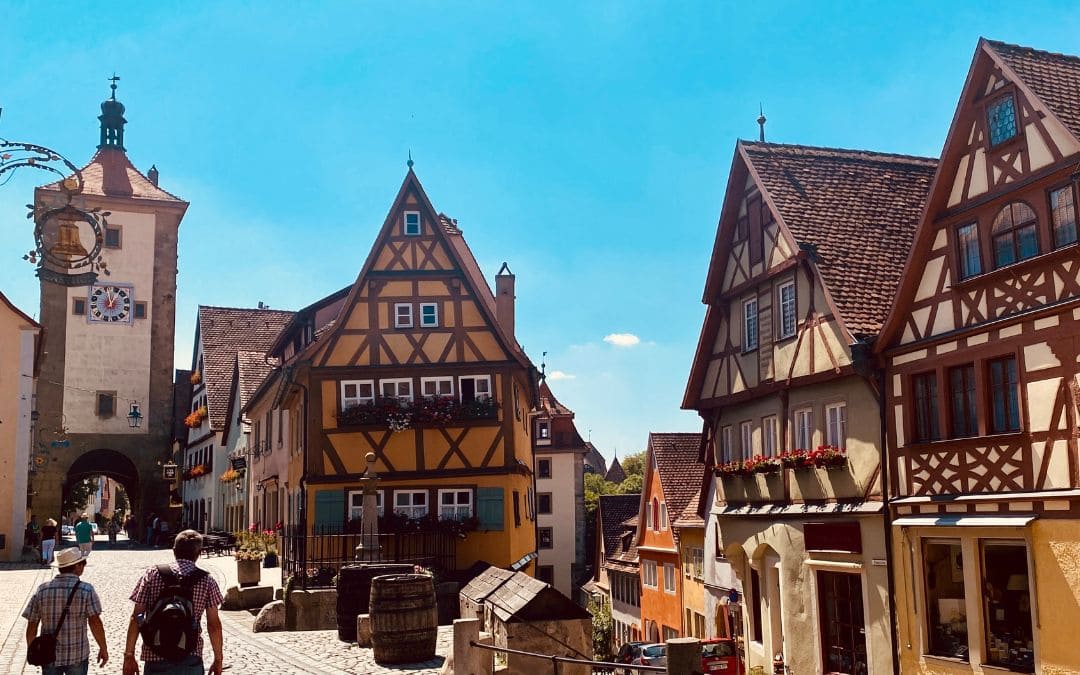
I admit - Rothenburg ob der Tauber is more of a village than a city. But: It is extremely charming and has everything that visitors expect from a typical German town: An intact city wall with towers and gates as well as a city center with many restored half-timbered houses. And of course the Käthe Wohlfahrt Christmas Shop. It is picturesquely situated on a hill and from many vantage points you can see the lovely Tauber valley .
Despite wartime destruction, Rothenburg managed to preserve a harmonious medieval townscape without the building sins of the post-war period. With the Altar of the Holy Blood in the City Church of St. James and Holy Cross Altar in the Church of St. Peter and Paul in the district of Detwang you can see two masterpieces by Tilman Riemenschneider probably the most important German sculptor of the early Renaissance.
If you are in the area - for example, to visit Nuremberg or Würzburg, then definitely make a detour to Rothenburg - don't miss it! Enjoy the medieval flair and a summer evening in the beer garden directly on the Tauber! In December the Rothenburg Reiterlesmarkt - one of the most beautiful Christmas markets in Germany - gives the romantic town an additional magical glow. And when a few snowflakes fall, you'll feel like you're in a winter wonderland!
- Visit St. Jacob's Church with the Altar of the Holy Blood by Tilman Riemenschneider
- Walk around Rothenburg on the city wall with its gates and towers
- Admire the ensemble of buildings around the Market Square with the town hall, the council drinking house, St. George's fountain, St. Mary's pharmacy and the butcher's shop
- Take a selfie at Rothenburg's most popular photo spot, the Plönlein
Extra Tip: My friend Ina Elser is a city guide in Rothenburg and offers entertaining and informative tours in German, English, French and Spanish language on. She will tell you a lot about Rothenburg that you won't find in any travel guide!
Spend the night in Rothenburg ob der Tauber - right in the middle of medieval flair
The medieval old town of Rothenburg is a journey through time - with its narrow alleyways, towers, the famous Plönlein and the fully preserved town wall. It is almost impossible to park directly in the old town, but there are large, easily accessible parking lots around the city wall where you can leave your car for several days.
Here are three tips for every budget - all centrally located and bookable via Expedia.
Fair: Glocke Winery and Hotel*
A family-run hotel with lots of charm, centrally located on the Plönlein - one of the most famous corners of Rothenburg. The cozy rooms, the personal atmosphere and the in-house restaurant with regional cuisine make your stay particularly pleasant. The hotel also has its own garage (for a fee).
Comfortable: Hotel Eisenhut
This traditional 4-star hotel is located in the heart of the old town and offers historic rooms with a half-timbered flair and a quiet courtyard terrace. You can reach all the main sights on foot - and park your car conveniently in one of the nearby public parking lots outside the city walls.
Upscale: Romantic Hotel Am Markusturm
A stylish boutique hotel in one of the oldest buildings in the city. Each room is individually furnished and combines a medieval ambience with modern comfort. The service is warm and personal, the location ideal. You can park in a nearby parking lot in the old town - it's a short walk to the hotel to drop off your luggage.
Stuttgart (Baden-Württemberg): Between Cosmopolitan Flair, Culture and Vineyards
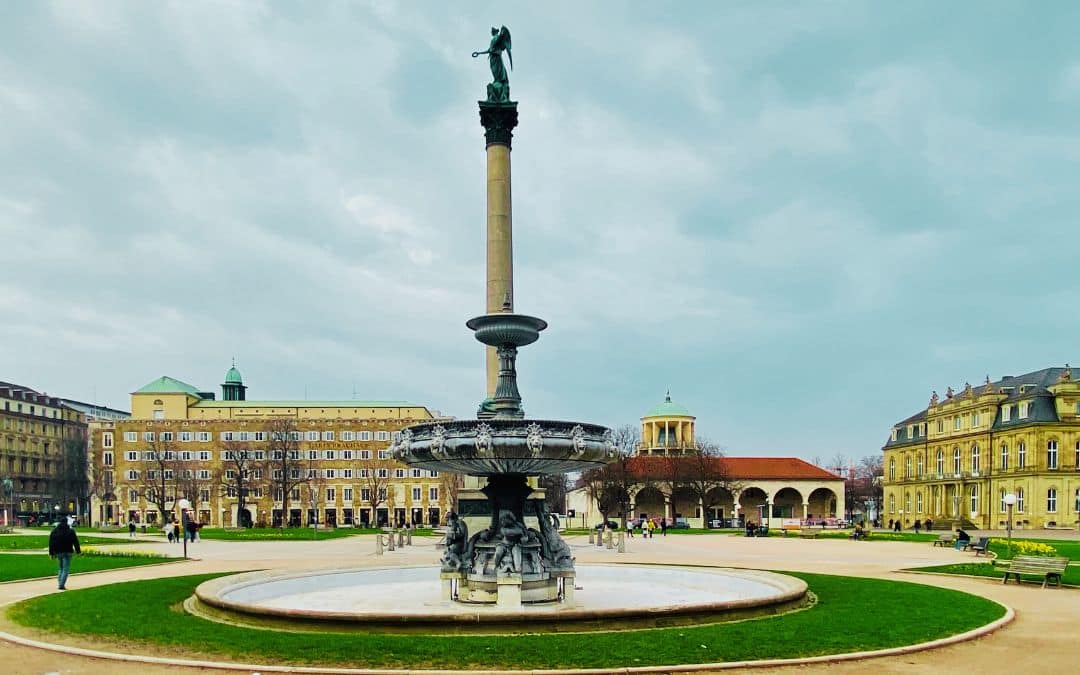
Stuttgart, the capital of Baden-Württemberg, impressively combines tradition and modernity. Nestled in a picturesque hilly landscape, the city is known for its green oases, its rich cultural heritage and a unique combination of viticulture and urban life. I myself was born in Stuttgart and live very close by - so I know the city particularly well and can say first-hand: it has a lot more to offer than many people think!
A central point of attraction is the Schlossplatz,surrounded by the impressive New Castle (Neues Schloss)the Old Castle and other historic buildings. In the immediate vicinity is the Königstrasse, one of the longest shopping streets in Germany, which invites you to stroll and linger. For art lovers, the Stuttgart State Gallery (Staatsgalerie Stuttgart) with its impressive collection of works from the 14th century to modern times is a must. It is also famous for its postmodern extension by British star architect James Stirling.
I don't want to be dead and buried
As emperor in Aachen in the cathedral;
Far rather would I live as the humblest poet
In Stuttgart by the Neckar's flow.
But Stuttgart also has a lot to offer outside the city center: In the Weißenhofsiedlung In the north of the town there is a detached house and a semi-detached house that Le Corbusier 1927 for the Werkbund exhibition and which is part of the UNESCO World Heritage Site "The architectural work of Le Corbusier" are. The Weißenhof Museum is also located in the semi-detached house.
Automobile fans come to the Mercedes-Benz Museum and Porsche Museum The history and development of these world-famous brands are on display. Another highlight is the Wilhelma, a zoological-botanical garden in Moorish style that delights both animal and plant lovers.
In Stuttgart, Friedrich Schiller attended the Hohe Karlsschule at Solitude Palace, a military academy that strongly influenced his youth. A visit to the castle is particularly worthwhile in fine weather, as the view is magnificent, and the green surroundings are perfect for long walks.
Wine growing in the middle of the city is also unique! The Stuttgart vineyards extend into the city center and give the metropolis a special flair. A walk through the vineyards around Rotenberg with the burial chapel on the Württemberg offers fantastic views as well as the opportunity to taste Swabian wines directly from the winegrower.
For those interested in art and culture, Stuttgart offers a perfect mix of historical sights, first-class museums and culinary delights. The diverse gastronomic scene ranges from traditional Swabian specialties to international cuisine, often served in cozy wine taverns or modern restaurants with views of the city.
Stuttgart is also known for one of the largest "Oktoberfests", the Cannstatter Wasen, as well as for one of the most beautiful and popular Christmas markets in Germany. In the SI Center Stuttgart offers two of Germany's largest musical theaters, not far from the airport.
- Schlossplatz & Königstraße: The heart of the city with impressive architecture, the New Palace and the longest shopping street in southern Germany.
- Stuttgart State Gallery: One of the most important art collections in Germany with works from the Renaissance to modern times.
- Stuttgart TV tower: The world's first television tower of its kind offers a spectacular view over the city and the Neckar valley.
- Mercedes-Benz & Porsche Museum: Two legendary car brands present their fascinating history and innovations here. A must for car lovers!
- Extra Tip: Wine hike on the Rotenberg with a magnificent view of the Neckar valley from the viewing platform of the burial chapel on Württemberg hill and a visit to a wine bar or a Besenwirtschaft in Uhlbach - for an enjoyable finale with regional wine.
Stay overnight in Stuttgart - central, stylish and as far away from construction sites as possible
Stuttgart has many attractive locations, but the huge permanent construction site around Stuttgart 21 continues to affect large parts of the station district. Even some luxury hotels near the station are currently not really recommended - too loud, too inconvenient. This makes it all the more important to choose a hotel that is Good connections, quiet location and within walking distance of the city center to pay attention.
Here you will find three reliable tips for different budgets - modern, centrally located and far away from the construction site.
Fair: Premier Inn Stuttgart City Center*
A modern, new hotel right next to the shopping center Milaneo and the subway station Budapest Square. The rooms are bright, spacious and very well equipped. The location outside the construction site area and the unbeatable price-performance ratio make this hotel an excellent choice for budget travelers.
Comfortable: Motel One Stuttgart Main Station*
Central, quiet and charming: this Motel One is located in a side street Away from the construction sitebut still right in the city center. Many sights - such as Schlossplatz or Königsstraße - are within easy walking distance. The rooms are modernly furnished, air-conditioned and the green inner courtyard is a real highlight. Public underground parking garage with direct access available.
Upscale: Jaz in the City Stuttgart*
A stylish design hotel with urban flair, right next to the Milaneo. Large rooms with high-quality furnishings, rooftop bar, spa area and creative interior - here you can stay overnight with a view of the Kessel in a relaxed, young atmosphere. The Subway station Stadtbibliothek is only 150 m away - it is only two stops to Schlossplatz (one to the main station!).
Trier (Rhineland-Palatinate): A journey through time from the Romans to Karl Marx
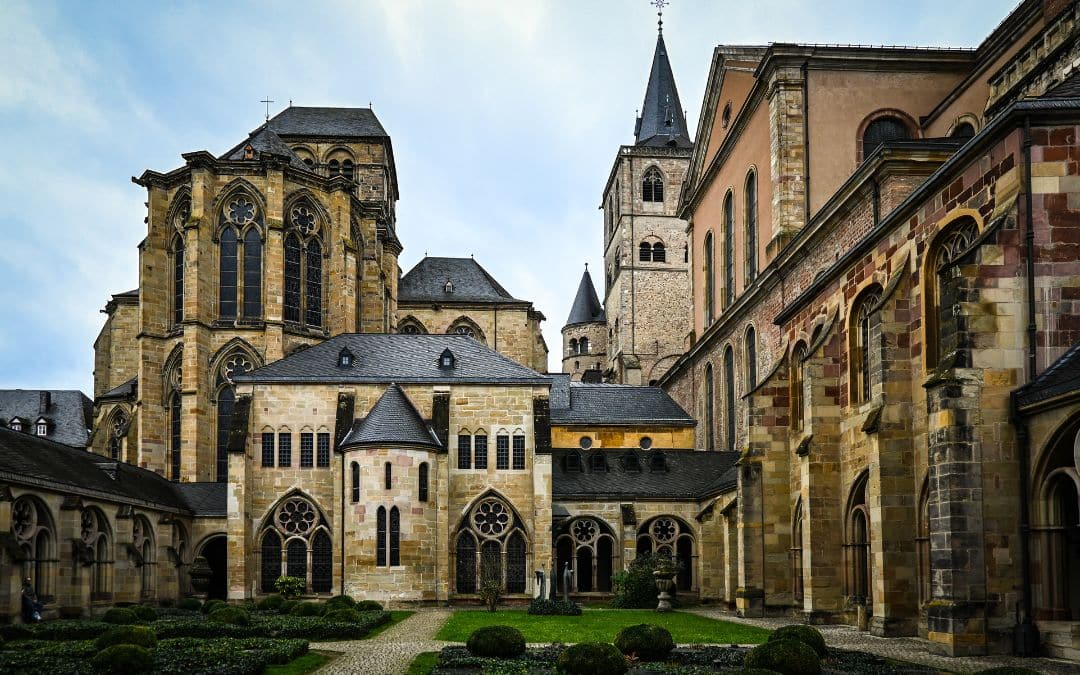
Trier, the oldest city in Germany, was founded in 17 BC under the name of Augusta Treverorum and impresses with a wealth of Roman monuments that characterize the cityscape. The most famous landmark is the Porta Nigra , an imposing city gate from the 2nd century AD, which today is part of Trier's UNESCO World Heritage. Equally worth seeing are the Imperial Baths, one of the largest preserved Roman baths north of the Alps, and the ruins of the Barbara Baths and Roman bridge across the Moselle.
But it is not only antiquity that is omnipresent in Trier: the imposing St. Peter's Cathedral, the oldest cathedral in Germany, combines architectural styles from several centuries and is together with the neighboring Church of Our Lady on the UNESCO World Heritage List. The Liebfrauenkirche, one of the earliest Gothic churches in Germany, is fascinating with its cruciform layout and ornate tracery windows.
Treveris ex urbe deus complet dona sophiae.
(In the city of Trier, God brings the gifts of wisdom to perfection).
In addition to being shaped by the Roman emperors Constantine, Augustus and Marcus Aurelius, Trier is also known as the birthplace of another important personality: Karl Marx, philosopher, revolutionary and one of the most influential thinkers of the 19th century, was born here in 1818. His birthplace in Brückenstraße is now a museum dedicated to his life and work.
A stroll through the winding alleyways of the old town takes you past historic buildings, cozy wine taverns and impressive squares such as the main market square and the cathedral courtyard. For those interested in art and culture, Trier offers a perfect mix of history, architecture and culinary delights - a city that invites you to discover and enjoy.
A visit to Trier is also worthwhile in December - the oldest city in Germany also scores with one of the Germany's most beautiful Christmas markets.
- Guided tour of the old town: Experience the history of Trier up close on a guided tour through the old town. Find out exciting details about the Porta Nigra and other buildings that are part of Trier's UNESCO World Heritage sites buildings such as the cathedral and the Liebfrauenkirche, as well as the Hauptmarkt, the historic heart of the city.
- Imperial Baths: The imposing remains of the Roman thermal baths are one of the largest bathing facilities north of the Alps. The underground passages and ruins give an idea of how luxurious life was in Roman times.
- Rheinisches Landesmuseum Trier: One of the most important archaeological museums in Germany, which displays impressive Roman mosaics, sculptures and tombs. In 2025, the great Marcus Aurelius National Exhibition — is a must for history buffs! [👉You can find more tips for cultural theme years in Germany in my article CMT 2025: Ideas for vacations, city trips and day tours in Germany]
- Karl Marx House: The birthplace of the world-famous philosopher Karl Marx, is now a museum dedicated to his life, work and the history of his influence - an exciting place for anyone interested in philosophy and social history.
Staying overnight in Trier - historic, relaxed and well located
Trier, the oldest city in Germany, is a wonderful place to explore on foot: Porta Nigra, the cathedral, the Imperial Baths and the Roman Bridge are all close together. Accommodation close to the city center is therefore worthwhile - for short distances, charming old town flair and spontaneous discovery tours.
Here you will find three personally selected hotels - from practical to stylish - that are the perfect starting point for your city exploration.
Fair: Mercure Hotel Trier Porta Nigra*
Top location directly opposite the Porta Nigra: the Mercure Hotel offers modern rooms with comfortable furnishings, many with a view of the Roman landmark. The old town is right on the doorstep and the main train station is only a few minutes away. Ideal for anyone who wants to stay close to the city center at a reasonable price.
Comfortable: Best Western Hotel Trier City*
Modern city hotel in a central location, just a few minutes' walk from the pedestrian zone. The functionally furnished rooms, friendly service and extensive breakfast buffet ensure a pleasant stay. A solid choice for a city trip with good value for money.
Upscale: Romantik Hotel Zur Glocke*
A boutique hotel with history: Individually furnished rooms with stylish interiors and traditional elements await you in a lovingly restored old town house. Especially nice: the hotel's own inn with regional cuisine in a rustic ambience. The ideal choice for anyone who wants to combine comfort with historical flair.
Continue reading
You can find out what else you can see and experience on the Moselle in my article about Germany's most beautiful regions.
Weimar (Thuringia): Germany's cultural center
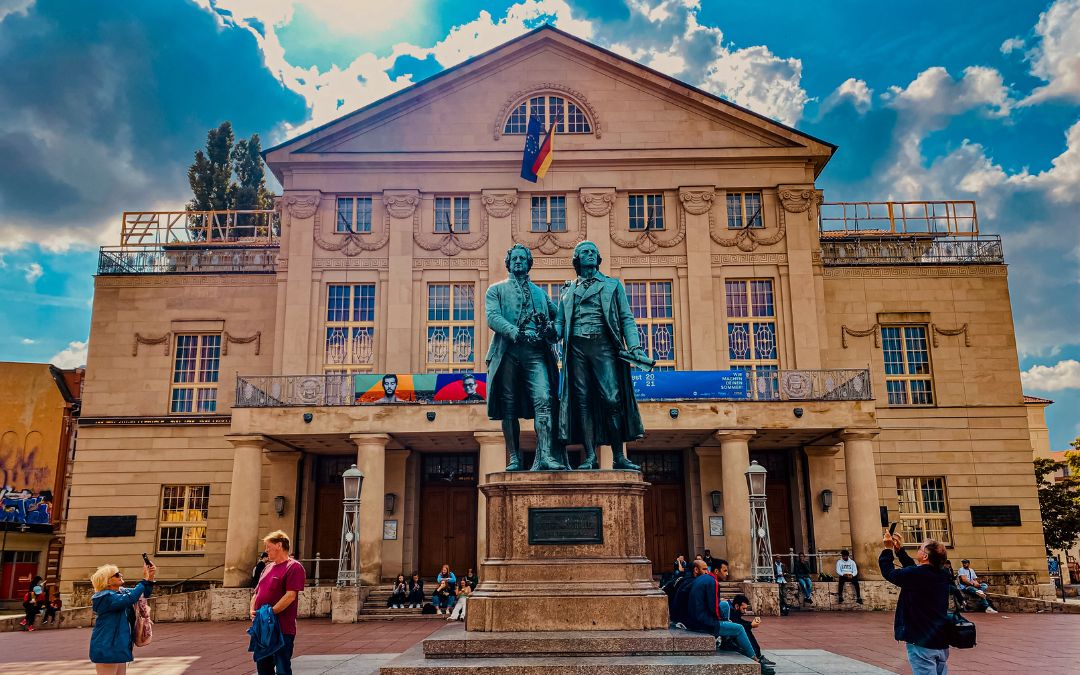
Weimar's significance is of a spiritual nature. It consists less of imposing buildings than the feeling of traveling back in time to the 18th and 19th centuries, when Weimar was the intellectual center of Europe .
The "Golden Age of Weimar" refers to the time of the interaction of Goethe and Schiller in the "Ilm-Athens". Thus, the most famous monument of the two stands in front of the German National Theater, which Goethe directed from 1791 to 1817 and at which they both worked together for several years.
Why did Weimar become Germany's cultural center in the Classical period, and not Berlin or Munich? Duke Carl August I of Saxe-Weimar-Eisenach, who like his mother Anna Amalia was an avid lover of art, stopped in Frankfurt in 1774, where he invited Goethe, already world-famous at the time for "The Sorrows of Young Werther" and "Goetz von Berlichingen," to Weimar. This was the beginning of a lifelong male friendship as well as the Weimar Classicism. Superstar Goethe attracted other poets and scholars to Weimar, including Schiller and Herder. In a time of great changes and revolutions, a diversely talented generation of artists met a princely house that was willing to support them financially as well. Goethe's first residence in Weimar - the garden house in the park on the Ilm - and also his house on the Frauenplan were gifts from the duke. The enormous range of geniuses in the fields of literature, theater, philosophy and music made the Weimar Classical period so unique. The UNESCO World Heritage Site "Classical Weimar" comprises 16 objects, including Goethe's and Schiller's residences, the Duchess Anna Amalia Library and the park on the Ilm with Goethe's garden house.
The history of German culture is inconceivable without Weimar.
The "Silver Age" followed in the years after 1850, when composers such as Franz Liszt and Richard Wagner worked in Weimar.
Weimar shone once again in the period around 1920, when Walter Gropius founded the Bauhaus and attracted such important artists as Lyonel Feininger, Gerhard Marcks, Paul Klee, Oskar Schlemmer and Wassily Kandinsky to the art school. Due to the increasing power of the Nazis in Weimar, the Bauhaus moved to Dessau in 1925. Since 1996, three Weimar Bauhaus sites have been part of the Bauhaus UNESCO World Heritage sites.
During the darkest period, the Nazis established the largest concentration camp on German soil, the Buchenwald concentration camp, at the gates of the city. Visible from afar is the 50 m high bell tower in the center of the complex, which was erected in 1958 to commemorate the 56,000 dead of the camp.
But besides the museums and memorials, which are all worth visiting and make Weimar an interesting destination for a city trip, people also like to celebrate here. The Goethe Wine Festival around Goethe's birthday, August 28, the Onion Market in October and the Weimar Christmas in December might give you additional reasons to visit Weimar.
I've been to Weimar twice before for four days each time and will go again in December. I love to walk through the Park on the Ilm, and Goethe's garden. Not only the poet memorials, but also the great Rococo Hall of the Anna Amalia Library, the Historical cemetery and Bauhaus Museum have left a lasting impression with me. Weimar is definitely one of my favorite cities in Germany!
- Sightseeing tours, without which you should not leave Weimar and which all belong to the UNESCO World Heritage Site "Classical Weimar count Anna Amalia Library, Goethe's Residence, Schiller's Residence, Park on the Ilm with Goethe's Garden House, Historical Cemetery with Prince's Crypt (with the coffins of Goethe and Schiller); the City Palace is currently being renovated and is expected to be closed until 2030.
- Enjoy the view of Weimar from Belvedere Palace and stroll through the parks like the Weimar nobility and their illustrious guests in their days
- Find out more about the most important design and art school of the 20th century in the Bauhaus Museum with more than 13,000 exhibits.
- Take a day trip to Erfurtwhich is only 24 km away from Weimar, visit the Petersberg Citadel, the Cathedral Hill with two cathedrals and medieval old town with the Krämerbrücke.
👉 Click here for my detailed Weimar City Guide.
Stay overnight in Weimar - stylish, historic and central
Weimar is a city full of culture, history and elegance - ideal for anyone interested in Goethe, Schiller, Bauhaus and classicism. The old town is manageable and much can be explored on foot. A central location pays off - not only for short distances to the most important museums, but also for relaxed walks through parks and squares with history.
Here you will find three stylish accommodation recommendations for different budgets - all right in the heart of Weimar.
Fair: Hotel Schillerhof*
Modern, quiet hotel in an excellent central location - just 100 m from the Deutsches Nationaltheater. The rooms are comfortably furnished and many cultural highlights are within easy walking distance. Ideal for price-conscious city travelers with a taste for culture.
Comfortable: Amalienhof Hotel Weimar*
A charming old town hotel with plenty of atmosphere - just 100 m from the Goethe House. The individually designed rooms, a light-flooded conservatory and the roof terrace with a view of Goethe's garden make this hotel a stylish retreat in the heart of Weimar.
Luxurious: Hotel Elephant Weimar, Autograph Collection*
The classic among Weimar's hotels: this traditional 5-star hotel is located directly on the market square and combines historical elegance with modern comfort. Art, design and excellent service characterize the stylish ambience - perfect for anyone who wants to stay in the footsteps of great minds.
Würzburg (Bavaria): World heritage, science and wine culture
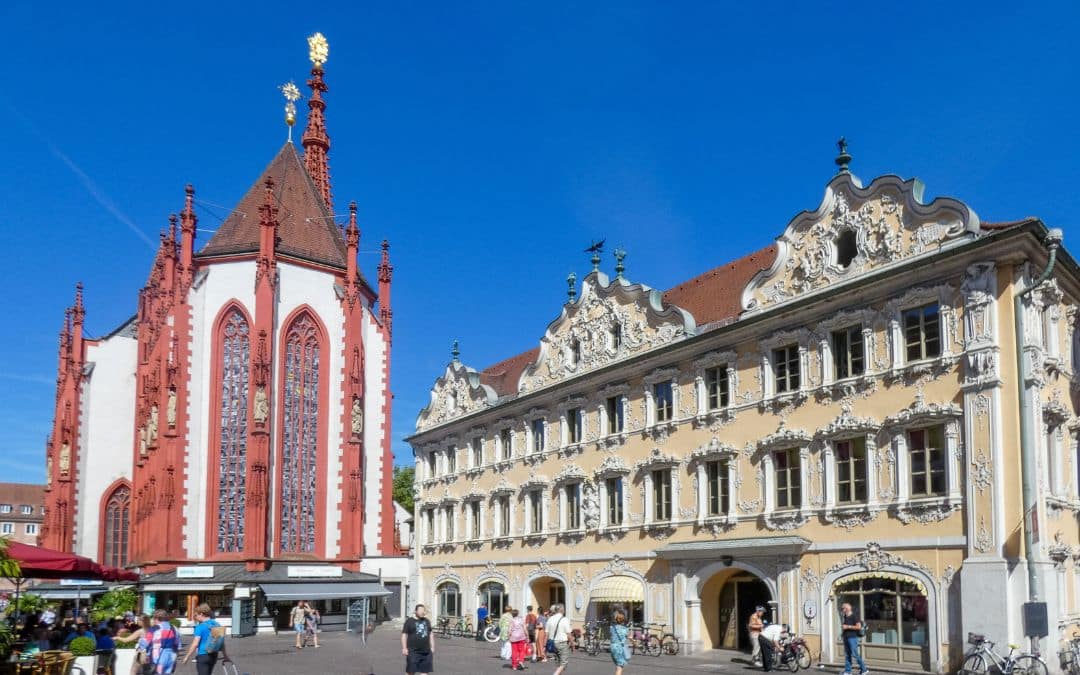
Inexplicably, Würzburg still seems to be an insider tip among the beautiful cities of southern Germany. Alongside great artists such as Balthasar Neumann and Tilman Riemenschneider the city produced 14 Nobel Prize winners . Wilhelm Conrad Röntgen was the first one of them after he discovered the X-rays in 1895. The city center is not too big and invites you to explore its cultural and historical treasures on foot.
Happy Würzburg, excellent people, faithful country...
The history of Würzburg is inextricably linked to the formative role of the prince-bishops, who determined the spiritual and secular life of the city for centuries. Their residences, first the majestic Marienberg Fortress and later the magnificent Würzburg Residence, are silent witnesses to the power and influence exercised by these rulers.
Originally, the Marienberg Fortress,which towers high above the city and the River Main, was the seat of the prince-bishops. With its fortified walls and towers, the fortress tells of a time when Würzburg and its rulers were repeatedly at the center of historical conflicts. A walk offers interesting insights into the past and an incomparable view of the city and the River Main.
As the need for defensive fortifications diminished and the desire for representation and comfort increased, Prince-Bishop Johann Philipp Franz von Schönborn had a new residence built in the heart of the city. His architect Balthasar Neumann created the Würzburg Residence In collaboration with artists and master builders from all over Europe. A Baroque masterpiece was created that reflects the wealth and cultural ambitions of the prince-bishops. It is not for nothing that the residence was listed as a UNESCO World Heritage. .
The Old Bridge connects both the banks and the people. After a walk across the bridge, which is lined with baroque statues of saints, visitors and locals meet up for a glass of wine.
The Lady Chapel (Marienkapelle),known for its "Schwalbenlädle", small stalls arranged on the outer walls between the buttresses, gives the market square a special charm. The figures of Adam and Eve at the south portal of the Marienkapelle are early works by Tilman Riemenschneider. However, you can only see copies here - the originals are in the Main-Franconian Museum at the Marienberg Fortress.
The region's winemaking tradition goes back a long way and is an integral part of the local identity and way of life. Würzburg is located in the heart of Franconian wine country and is known for its exquisite wines. A highlight for wine lovers is the wine cellar of the Juliusspital, a foundation that has existed since the 16th century and uses the proceeds to support social institutions.
All information about Würzburg's most important sights can be found in my detailed blog article Würzburg Sightseeing - The Complete City Guide (with Map)
Take your time to discover Würzburg and all its facets. It's also worth planning a few extra days to explore the beautiful surroundings. You can find lots of tips for excursions in the Würzburg region in my article Day Trips from Würzburg - the 11 Most Beautiful Destinations, .
- Plan half a day to visit one of the most important baroque palace complexes in Europe, the Würzburg Residence.
- Hike in the late afternoon (best light) up the Marienberg Fortress, and enjoy the view of the city, the River Main and the surrounding area of Würzburg.
- On the way back from the fortress to the city, enjoy a "Brückenschoppen" on the Old Bridge and take a closer look at the bridge saints.
- Take a boat trip to Veitshöchheim Palace,the former summer residence of the prince-bishops. The palace park with its arcades, picturesque lakes, bubbling fountains and around 300 sculptures is considered one of the most outstanding rococo gardens in Europe.
👉 Click here for my detailed Würzburg City Guide.
Stay overnight in Würzburg - central, comfortable and with historical flair
Würzburg combines baroque splendor with Franconian charm - sights such as the Residenz, the cathedral, the Old Main Bridge and the Marienberg Fortress are all close together. If you live centrally, you can explore the city on foot - whether on a tour of the old town or with a glass of Silvaner on the banks of the Main.
Here you will find three hotel recommendations for different budgets - all well located and with lots of character.
Fair: City Partner Hotel Strauss*
Centrally located on the Juliuspromenade, this hotel is an ideal starting point for your visit to Würzburg on foot. The rooms are comfortably furnished, the breakfast buffet is varied and Franconian specialties are served in the in-house restaurant. A solid choice for anyone who is traveling on a budget but doesn't want to compromise on comfort.
Comfortable: Hotel Würzburger Hof*
This traditional hotel is located directly at the entrance to the Old Town, just a few minutes' walk from the cathedral, the Residenz and the Old Main Bridge. The individually designed rooms are stylishly furnished with attention to detail. The personal service and the rich breakfast in an elegant ambience are particularly appreciated - ideal for all those who want to combine comfort with historical flair.
Luxurious: Steinburg Castle Hotel*
Situated high above the city in the middle of the vineyards, the Schlosshotel Steinburg offers elegant luxury with a fantastic view. In addition to stylish rooms, an excellent restaurant and a spa area with pool and sauna await you. Perfect for a romantic weekend or a stylish break with a view.
Conclusion: My Top 3 most Beautiful Cities in Germany
Honestly, it's impossible to choose the most beautiful of all the fascinating German cities! In the end, I avoided this because I chose my top 3. The result will probably surprise you - and I'm heartbroken that I can't include Weimar and Heidelberg in my top 3. So here is my ranking:
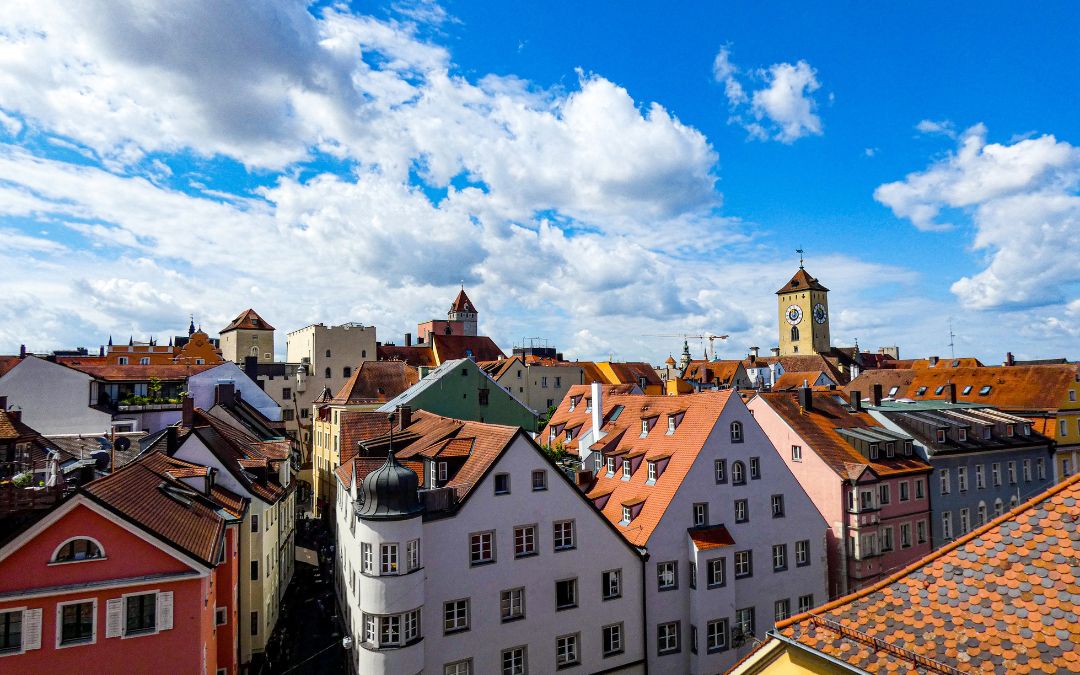
- Regensburg - the most beautiful
Since this post is about the most beautiful German city - not the most interesting, historic, culturally significant - this place goes to Regensburg for me. The intact medieval townscape with the many gender towers - you don't see that in this form anywhere in Germany. In addition the wide places, View from the Stone Bridge and the Danube bank on the city - simply beautiful! - Berlin - the most diverse
In fact, Berlin is my favorite city in Germany. Nowhere is the cultural offer larger than here. In addition, there are here the greatest museums, beautiful parks and lakes,and - what is particularly important to me - you can go deep into the german history immerse myself. I have been to Berlin many times in the course of my life and I always discover new and exciting things. Berlin is constantly changing and never gets boring! - Nuremberg - the most German
I have discovered Nuremberg - like Regensburg, Würzburg and Bamberg - only in 2022 and was immediately thrilled! From the early Middle Ages to the main war crimes trials after the Second World War, this city represents all facets of German history. In addition, Nuremberg is the Prime example of a medieval (albeit not original) German town with the powerful Imperial Castle, a largely intact city wall and many Bridges and towers. I liked Nuremberg so much that I went twice last year!
Book recommendation
Caro and Martin from WE TRAVEL THE WORLD have a travel guide about 11 underrated cities in Germany*, in which Regensburg and Bamberg, for example, are also presented. I used the travel guide to get an initial overview of the most important sights, best restaurants and accommodation in these great cities and found it extremely useful. Thanks to its practical format, it fits in every handbag - but it is also available as an e-book!
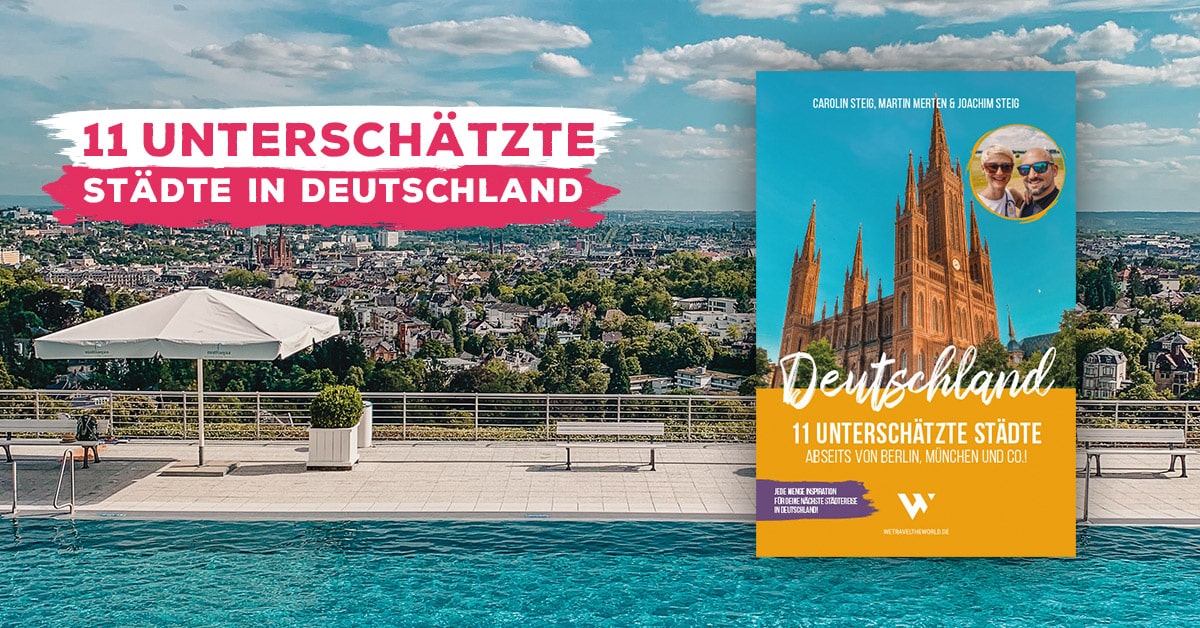
And What Do You Think?
As I said before, my selection of the most beautiful German cities is completely subjective and can change at any time. I am very interested in what your favorite city or cities are in Germany. Maybe it's even a city that I haven't mentioned. Write me in the comments what your favorites are and what excites you about this city or these cities! I am already very curious.


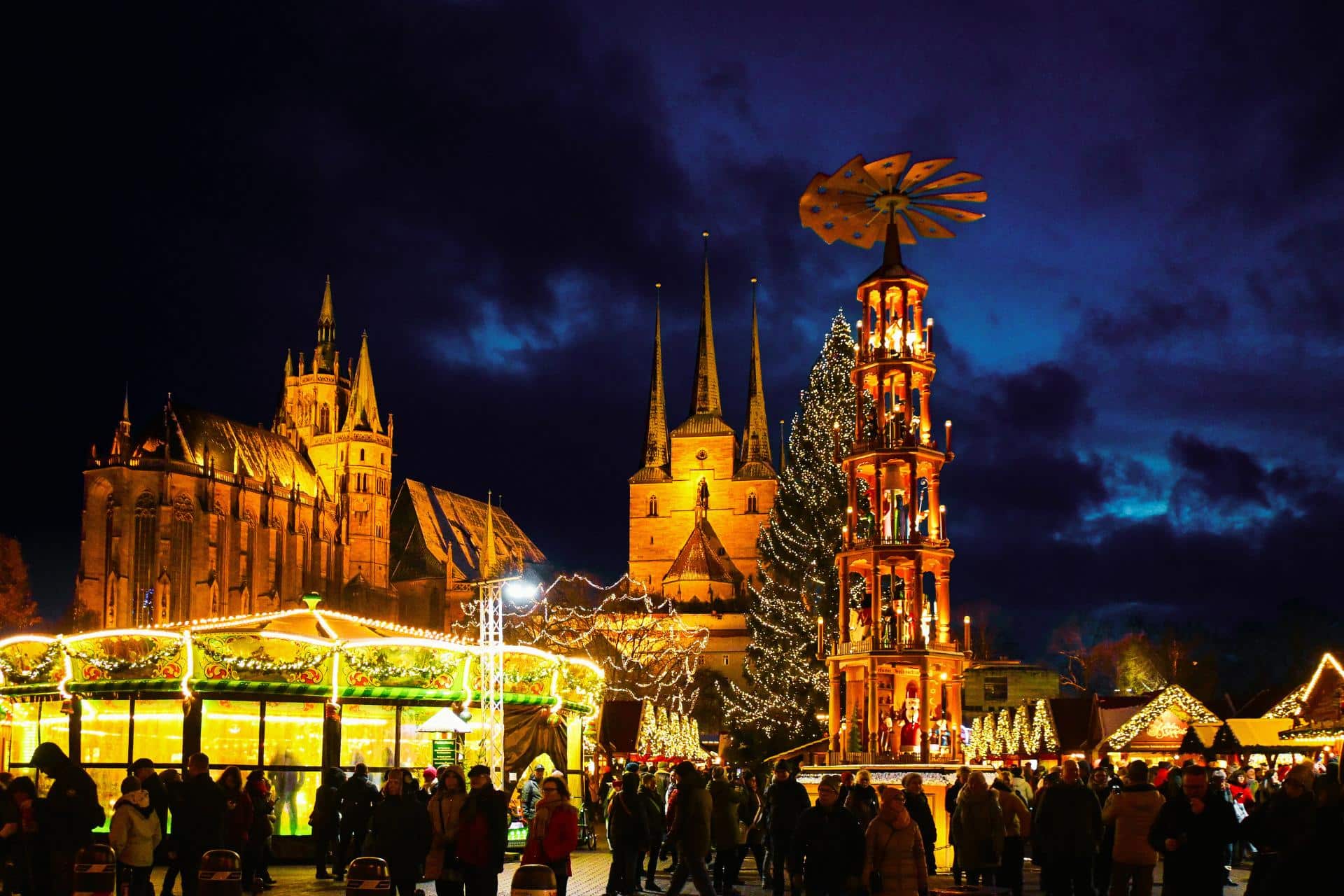
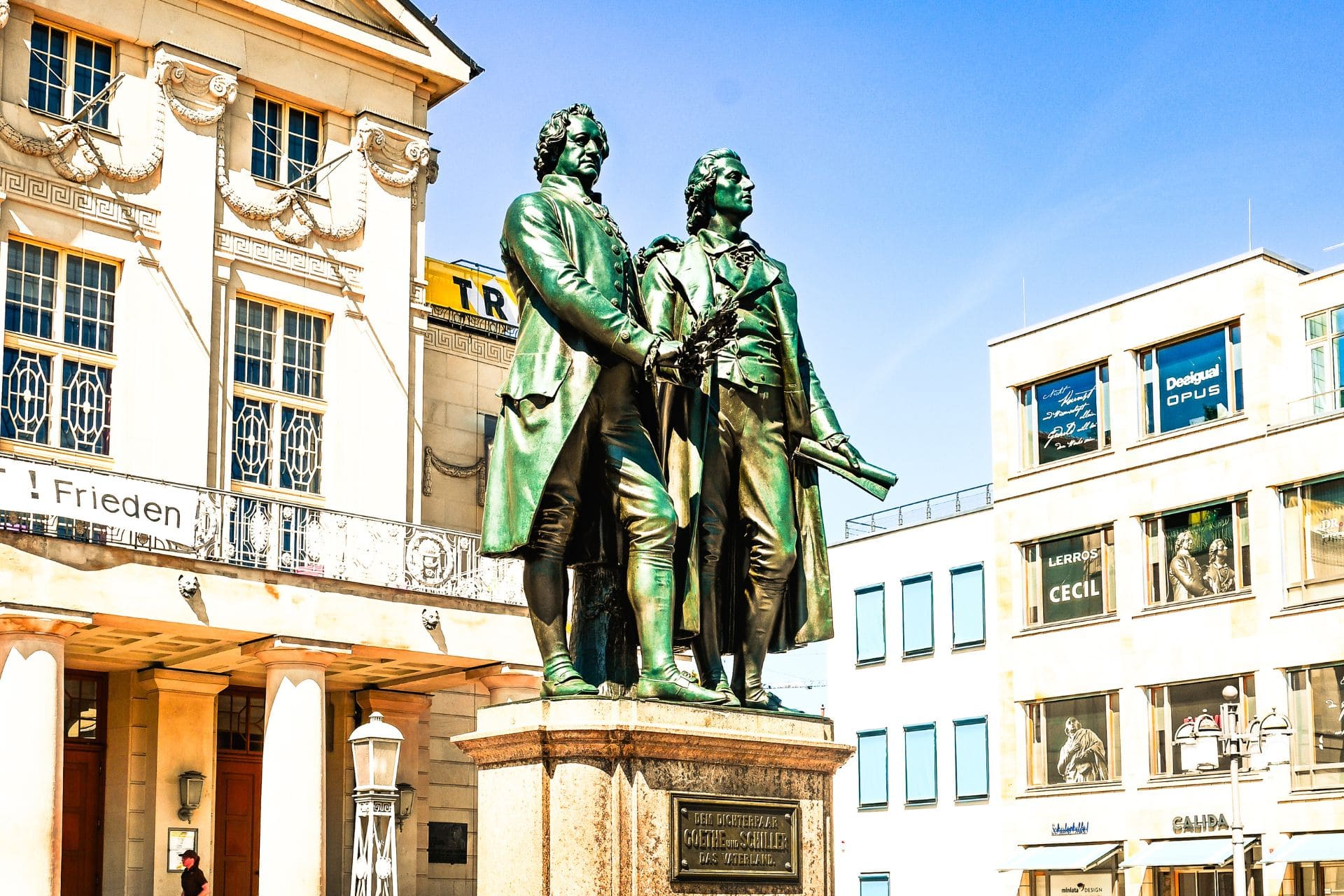
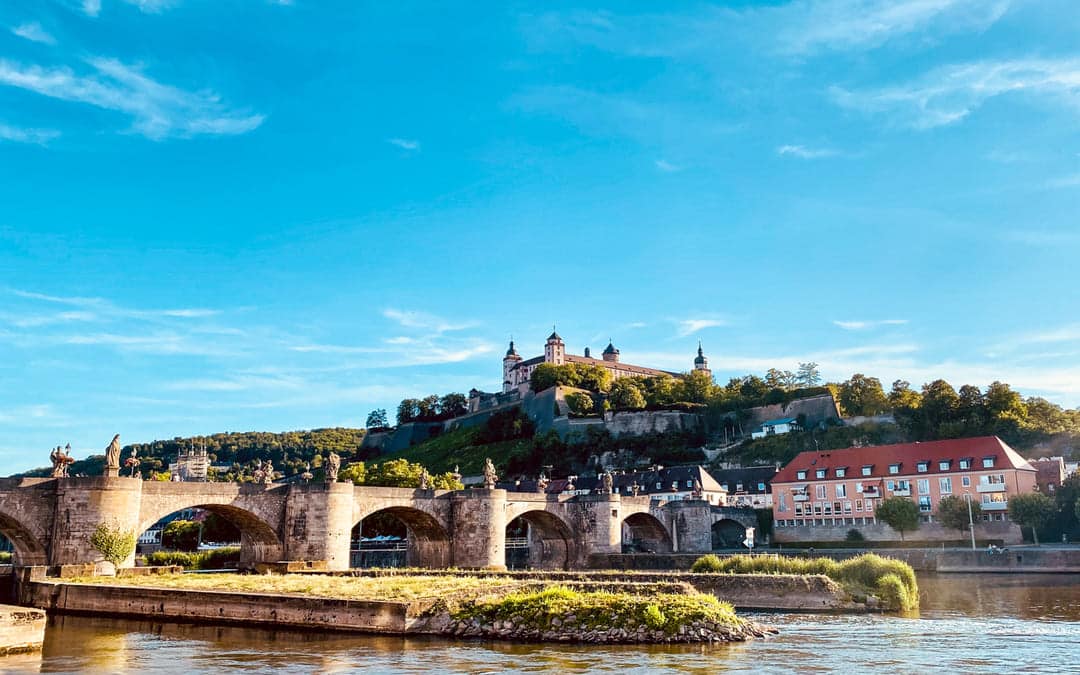
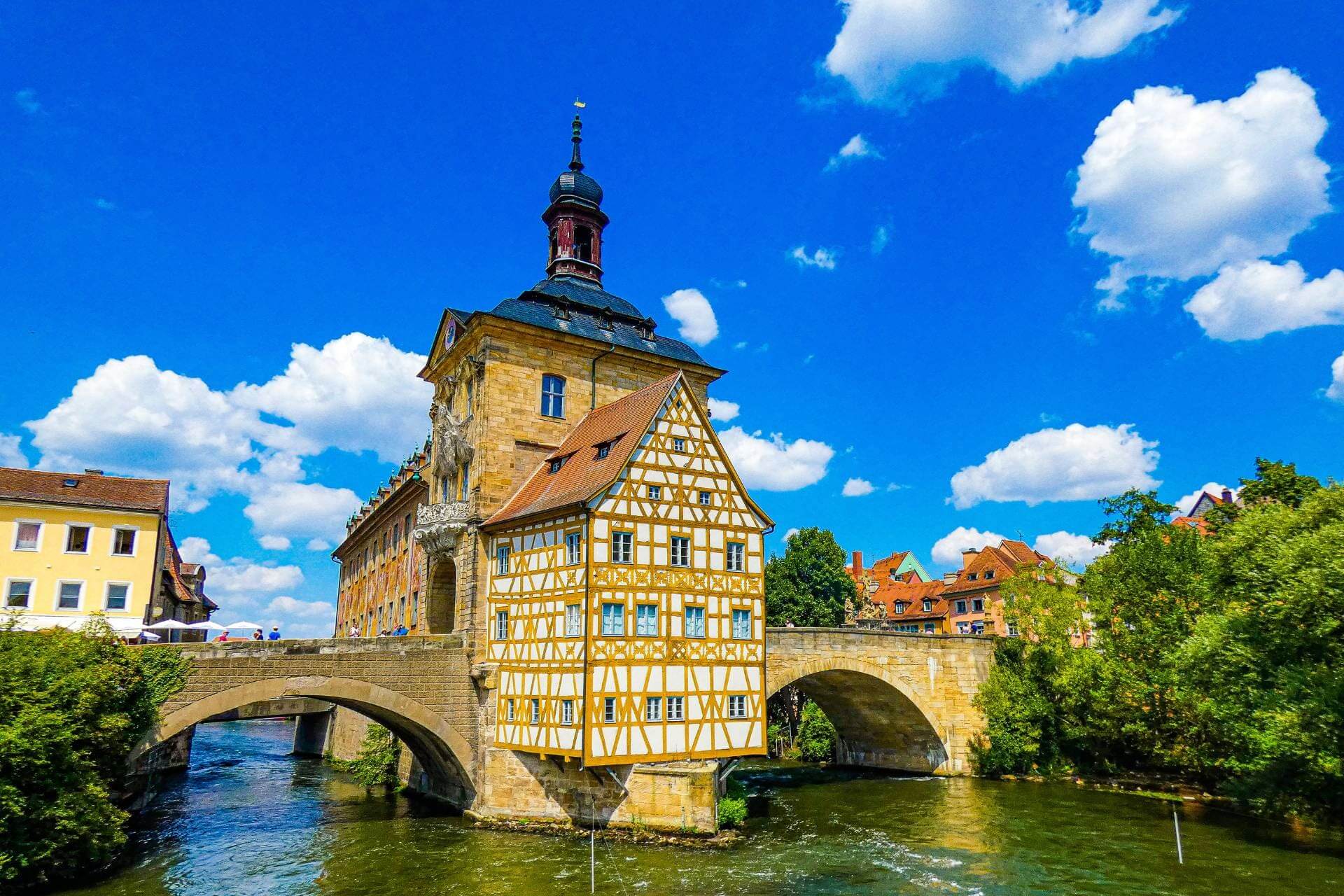
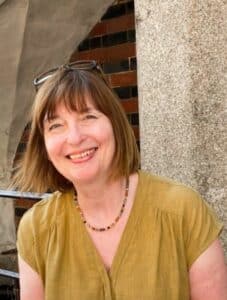
Hello dear Angelika,
The Christmas calendar newsletter door with Leipzig is particularly inspiring again today. You just want to go there and hear the choir live. Through your calendar doors I can dream myself away in my pre-Christmas hustle and bustle. Thank you for this respite and warm Advent greetings from Silvana
Dear Silvana,
It's great that you're enjoying the virtual Christmas market tour so much😃. That was exactly my intention! There are still a few doors left ... Have fun on your "onward journey" ...
Best wishes and happy holidays!
Angelika
Hello Angie,
Ringelnatz's saying certainly encourages you to find out more about Bremen, especially if you've only ever heard the fairy tale about the Town Musicians.
It was actually your Advent calendar with the Bremen Christmas market that got me thinking about Bremen again. I was once in Bremen more than 40 years ago, on my way to the North Sea. It was the first time I had a sailor's snack in the Ratsstuben - how exciting. It's great that your travel blog exists, you can reminisce even if you no longer travel yourself. Please keep up the good work! Warm Advent greetings from Silvana in the country
Dear Silvana,
How nice that my article brings back fond memories for you. You dined in Bremen's Ratskeller in a very historic place, like many famous people before you, such as Theodor Fontane, Hoffmann von Fallersleben and Bismarck. 😅 I only got to know Labskaus during my time in Bremen, but on a trip to Hamburg.
I wish you happy holidays and a happy new year!
Cheers,
Angelika
Dear Angelica,
What a beautiful list! In the list are very many cities that I also like so much - like Hamburg, Bremen or Leipzig. Unfortunately, I haven't seen that much of southern Germany yet. My absolute favorite German city is Cologne: not beautiful in the classical sense, but so lovable.
Many greetings from the Lower Rhine
Anja
Dear Anja,
thank you very much for your great comment and the tip! I've already set my sights on Cologne for a Christmas market tour in December. About 20 years ago I was in Cologne a few times to visit friends but I only remember the cathedral and the Rhine. It's time for me to take a closer look at the city again 😃. I think southern Germany has an incredible amount of beautiful cities and breathtaking landscapes. I'm sure you'll love it!
Love,
Angelika
Hello dear Angelica,
now I have looked at your favorites and fully agree.
I know all the cities and also consider them the most interesting and beautiful.
I like your references to beautiful plants in the vicinity.
Love Inge
Dear Inge, thank you for your nice feedback. I am glad that we are of the same opinion as far as the most beautiful cities in Germany are concerned😃. Best regards, Angelika
Dear Angelika, please excuse my late reply. We were on vacation after all! Even though I have a subjective view of Rothenburg ob der Tauber, I agree with you that it does not necessarily belong in the top ten of the most beautiful cities in Germany. If the query were to be the ten most beautiful cities with an old town center in Germany, then I would really want Rothenburg to be on the list. In your recommendations for Rothenburg, I would be happy if you would mention our diverse range of city tours and of course THE premium product of Rothenburg. The tour with the night watchman! The feminine alternative to the night watchman is a tour with the artisan widow Walburga or with the pretty Hildi. Otherwise I find your contribution very appealing and wish you much success with this website. Sincerely, Ina
Dear Ina, thank you very much for your comment. I'm glad you agree with me about the top ten😃 I'm planning to write an article about the most beautiful small towns (or the most romantic towns) in Germany in due course, and Rothenburg will definitely be among them. There will also be a separate, detailed article about Rothenburg 😃 Very best regards to Rothenburg, Angelika
Really! So interesting the selection of your "top ten". All of these cities I know and I love them. Regensburg had surprised me about 10 years ago especially because of its beauty and specialness. There is a historical hall in the city hall where I could participate in a festival. But from your selection, Weimar is my most beautiful and impressive city. In the heart of the great poets and thinkers! Schiller and Goethe! Where they lived and worked. Schiller's residence and Goethe's garden cottage inspired me the most. Thank you dear Angie, you have triggered wonderful memories in me.
Thank you very much, dear Ruth. I am very pleased that I was able to awaken beautiful memories in you. The party at Regensburg City Hall was certainly a very special experience. Weimar had the same effect on me as it did on you. I could have walked there forever in the footsteps of Goethe and Schiller and forgotten the time. When the renovation of the city palace is completed, I definitely want to go there again. Best regards, Angelika
Hi Angie, unfortunately I only know Berlin quite well from the top 3. A pulsating, constantly changing cosmopolitan city. Creative, colorful and quirky, sometimes chaotic. In addition to the diverse cultural offerings, I also appreciate the beautiful wooded and watery surroundings and the inner-city parks. The public transportation system is exemplary. But for me, Berlin has one strong competitor, and that's Hamburg.
The 'highlights' are aptly described in your travel blog. I particularly like the city quarters Blankenese and Winterhude,
I would put both cities in first place. Is of course purely subjective. Greetings Matthias
Dear Matthias, thank you for your great comment. I think I've never been to Winterhude😮. I'll have a look when I'm in Hamburg next time. Blankenese I also find very beautiful😍. Hamburg is really a very beautiful city. Honestly, the preferences change with me - depending on the last place I visited, which has completely thrilled me again😃. As for Berlin, we are completely in agreement. What you write are exactly the reasons why I always love to be in Berlin - the city is so colorful and lively as hardly any other. Best regards, Angelika